ARCHIVED - Annual Report 2013 to Parliament
This page has been archived on the Web
Information identified as archived is provided for reference, research or recordkeeping purposes. It is not subject to the Government of Canada Web Standards and has not been altered or updated since it was archived. Please contact us to request a format other than those available.
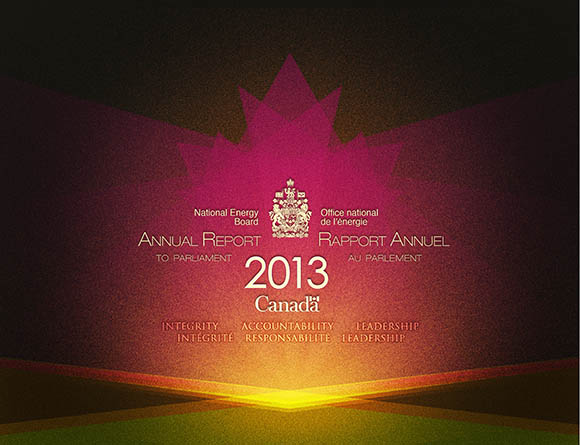
Copyright/Permission to Reproduce
ISSN 1498-5055

Purpose
We regulate pipelines, energy development and trade in the Canadian public interest[1].
Vision
The NEB is active and effective in Canada’s pursuit of a sustainable energy future.
Goals
- NEB-regulated facilities and activities are safe and secure.
- The environment is protected throughout the lifecycle of NEB-regulated facilities and activities.
- Canadians benefit from efficient energy infrastructure and markets.
- The rights and interests of those affected by NEB-regulated facilities and activities are respected.
Values
Integrity: We are fair, transparent, and respectful.
Regulatory Leadership: We are responsive, proactive and innovative.
Accountability: We are accountable and support each other to deliver timely, high quality results.
Strategies
We engage Canadians.
We hold those we regulate accountable for results in the public interest.
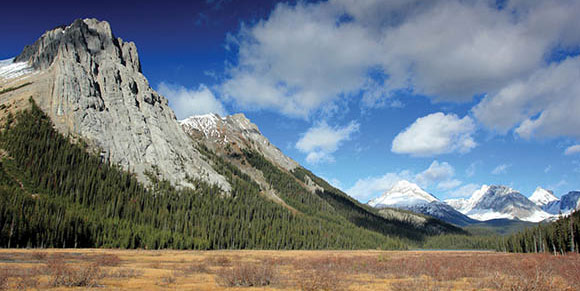
Chair's Message
 For over 50 years, the National Energy Board has provided regulatory oversight for Canada’s energy infrastructure under the Board’s jurisdiction. More than 450 staff come to work every day knowing they have the important responsibility of keeping Canadians safe and protecting the environment and promoting efficient energy infrastructure and markets.
For over 50 years, the National Energy Board has provided regulatory oversight for Canada’s energy infrastructure under the Board’s jurisdiction. More than 450 staff come to work every day knowing they have the important responsibility of keeping Canadians safe and protecting the environment and promoting efficient energy infrastructure and markets.
Our regulatory toolkit has expanded to better allow us to enforce compliance with legislation, regulation, conditions and orders. Companies are expected to carefully design and implement management systems to effectively assess risk and continually improve their operations with the end goal of keeping people safe and protecting the environment. The toolkit, stemming from the Jobs, Growth and Long-term Prosperity Act, includes an additional $13.5 million to hire additional staff and improve safety programs, as well as legislative changes that give the NEB new authorities in its regulation such as the ability to issue Administrative Monetary Penalties. We have also amended the Board’s Onshore Pipeline Regulations and Processing Plant Regulations with new and stricter rules that will protect Canadians and the environment.
Safety and the protection of the environment continue to be our top priorities, and our efforts are headed in the right direction. The goal of zero incidents is not only the right goal, but an achievable goal. Overall in 2013, we saw a decrease in reportable incidents. The frequency of natural gas releases was down, and while we saw an increase in the number of incidents with respect to liquids, overall release volumes were significantly down this year, and have been declining since 2009. In 2013, nearly all liquid releases from NEB-regulated energy facilities have been fully remediated, with exceptions only where cleanup is underway. Companies have been doing a better job of monitoring their facilities and reporting incidents.
The facilities we regulate are safe and the environment in which they operate is well protected. At the same time, we are Canada’s energy watchdog and our work is never finished. We strive to continually improve.
In June, the Board hosted a Safety Forum that facilitated dialogue among experts, academics, landowners, youth and leaders from both industry and regulators on safety management, continual improvement, and opportunities to improve safety outcomes. The broad takeaways from this forum were: a target of zero incidents is realistic; management systems, safety culture and measuring safety are the three fundamental ways to address pipeline safety; and we can never be satisfied that we have done all we can, but must embrace continual improvement. The Safety Forum was not the final step, but rather the latest step forward in our safety journey.
Companies regulated by the NEB are required to seek the Board’s approval for the export/import of energy, new construction or modification of energy infrastructure, tolls and tariffs, and abandonment. When a company applies to us, we take all aspects into consideration from environmental impacts to economic impacts and social considerations. In 2013, we received nearly 500 applications, and issued just under 550 decisions on imports and exports, as well as 18 hearing recommendations/decisions for energy infrastructure (new and/or modified), tolls and tariffs and abandonment. As part of those 18 recommendations/decisions, the NEB also this year, under the Joint Review Panel appointed under the National Energy Board Act and the Canadian Environmental Assessment Act, released the Enbridge Northern Gateway Project report.
The public actively engage with us on processes that lead to the Board’s decisions, recommendations and direction. This past year we conducted over 100 engagement activities for both regulatory applications and non-application initiatives, including over 50 meetings across the North. This also included activities under our Enhanced Aboriginal Engagement initiative. We work in the public interest so it is critical that we directly involve Canadians in our processes.
This is particularly true in the North. Engaging meaningfully with Northerners in developing a robust regulatory framework in the North is of great importance to the Board. This past summer Members of the Board along with NEB staff travelled to the Mackenzie Delta as well as communities in the Beaufort Sea and Baffin Island. These trips were not just about learning how energy development is perceived in this area of Canada. It was also about learning from the local communities in order to better understand the Northern way of life and the impacts development could have. This first-hand knowledge is important to ensure the Board is doing the right thing with respect to reviewing and strengthening a regulatory framework that focuses on safety and environmental protection in the North.
Given the dynamic nature of the energy sector in Canada, the Board continues to monitor the relationships between supply, infrastructure, demand and prices. When reviewing an application for an export licence, the Board considers whether the quantity to be exported is surplus to Canadian needs. In Canada, we are seeing an increasing demand for energy. At the same time, production and supply are increasing at a faster rate which results in larger amounts of surplus energy available for export. In 2013, NEB-regulated facilities shipped approximately $134.4 billion worth of products (liquids and gas) to Canadian and export customers, and approximately $2.7 billion of electricity went into and out of Canada. Even with exporting that amount of energy, we still have more than enough to meet the needs of Canadians.
There is much to be proud of in 2013, and the Annual Report highlights our activities and areas of focus. The NEB’s story is one about continual improvement and always looking to be better - and it is this ongoing evolution that I know will be the constant in the Board’s future as Canada’s energy regulator.
Original signed by
Gaétan Caron, Chair and CEO
Major Pipeline Systems and Frontier Activities
Regulated by the National Energy Board
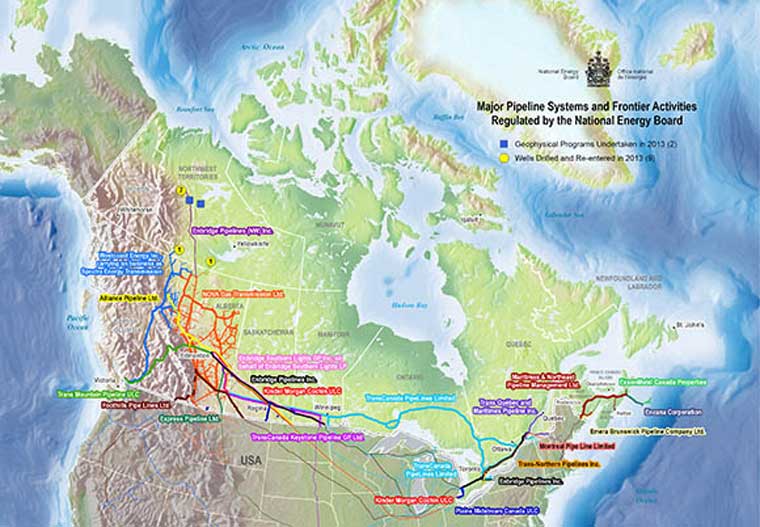
Our Roles And Responsibilities
The National Energy Board (NEB or Board) is an independent federal regulator established in 1959. Our mandate is to promote safety and security, environmental protection and economic efficiency in the Canadian public interest, in the regulation of pipelines, energy development and trade. The Board reports to Parliament through the Minister of Natural Resources.
In 2013, the NEB regulated 98 companies, which operate approximately 73,000 kilometres[2] of interprovincial and international pipelines, and related tolls and tariffs, and 28 companies that operate approximately 1,400 kilometres of international power lines across Canada. These pipelines shipped approximately $134.4 billion[3] worth of crude oil, petroleum products, natural gas liquids and natural gas to Canadian and export customers at an estimated transportation cost of $7.1 billion. NEB-regulated international power lines transmitted approximately $2.7 billion of electricity into and out of Canada.
The main responsibilities of the NEB are established in the National Energy Board Act (NEB Act). More information on the background and operations of the NEB can be found on the Board’s website, www.neb-one.gc.ca.
The safety of Canadians and protection of the environment in the construction, operation and abandonment of pipeline facilities are the Board’s top priorities.
Changes to the NEB’s Legislative Framework
Finalized Implementation of Changes Introduced under the Jobs, Growth and Long-term Prosperity Act
Implementation of Administrative Monetary Penalties (AMPs)
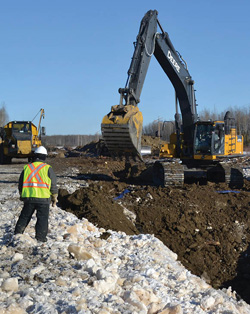 On 3 July 2013, new provisions of the NEB Act (sections 134 to 154) came into effect that establishes a system of AMPs to promote compliance with the NEB Act. The NEB Act stipulates that each day that a violation continues is considered to be a separate violation. This means that separate penalties could be issued per infraction, per day with no maximum total financial penalty. The NEB Act also sets out the maximum daily penalties: for companies, the maximum daily penalty is $100,000 per violation; and for individuals, the maximum daily penalty is $25,000 for each violation. The Board has conducted an extensive outreach program around AMPs and feedback received from stakeholders indicates that AMPs are a powerful deterrent.
On 3 July 2013, new provisions of the NEB Act (sections 134 to 154) came into effect that establishes a system of AMPs to promote compliance with the NEB Act. The NEB Act stipulates that each day that a violation continues is considered to be a separate violation. This means that separate penalties could be issued per infraction, per day with no maximum total financial penalty. The NEB Act also sets out the maximum daily penalties: for companies, the maximum daily penalty is $100,000 per violation; and for individuals, the maximum daily penalty is $25,000 for each violation. The Board has conducted an extensive outreach program around AMPs and feedback received from stakeholders indicates that AMPs are a powerful deterrent.
Navigable Waters
As a result of the Jobs, Growth and Long-term Prosperity Act amendments have been made to the NEB Act and the Canada Oil and Gas Operations Act (COGOA). These changes require the Board to consider project effects on navigation and navigation safety for NEB-regulated pipeline and power line crossings of navigable waters before recommendations or decisions are made under s. 52 and 58 of the NEB Act and s. 5.1 of COGOA. The amendments to the NEB Act and COGOA were enacted through an Order in Council which was issued in the Canada Gazette, Part II on 3 July 2013.
To ensure an effective transition of these responsibilities between Transport Canada and the NEB, the organizations signed a Memorandum of Understanding (MOU) that describes the co-operative relationship between the organizations as well as providing guidance on when a project is regulated by the NEB or Transport Canada.
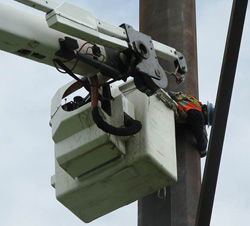 As a result of the legislative change, the NEB will take a more comprehensive review of project effects on navigation and navigation safety for pipeline and power line crossings of navigable waters.
As a result of the legislative change, the NEB will take a more comprehensive review of project effects on navigation and navigation safety for pipeline and power line crossings of navigable waters.
Amendments to the Power Line Crossing Regulations
The Power Line Crossing Regulations, SOR/95-500 (PLCR) arise from the amendments to the NEB Act in the Jobs, Growth and Long-term Prosperity Act. The Regulations Amending the Power Line Crossing Regulations, SOR/2012-238 (Regulations), made under the NEB Act were published in the Canada Gazette, Part II on 5 December 2012. These Regulations came into force on 3 July 2013. The Order in Council was published in the Canada Gazette Part II, on 3 July 2013.
Changes to NEB Regulation
The Board’s current Onshore Pipeline Regulations (formerly OPR-99) were originally brought into force in 1999 and updated over the years along with Canadian Standards Association revisions. While innovative for their time, the NEB believes strongly in continual improvement, and as a result, we have introduced further amendments to our regulations.
Amendments to the Onshore Pipeline Regulations (OPR)
The NEB’s regulations for onshore pipelines were amended on 10 April 2013. The OPR clarifies that companies must apply their management systems to all activities involving the design, construction, operation or abandonment of a pipeline, and to their protection programs for safety, environment, integrity, pipeline crossings, public awareness, emergency management and security. In addition, companies are now required to appoint an accountable officer who has the appropriate authority over the company’s human and financial resources to enable the company to meet its obligations for safety, security and protection of the environment. The NEB’s Audit Protocol and Guidance Notes for the OPR were updated to reflect the amendments and issued in July and September respectively.
The NEB has new and stricter rules for safety, security and protection of the environment.
Amendments to the Processing Plant Regulations
The Regulations Amending the National Energy Board Processing Plant Regulations, (Miscellaneous Program[4]), SOR/2013-17 were published in the Canada Gazette, Part II on Wednesday, 13 February 2013. The regulations address comments received from the Standing Joint Committee for the Scrutiny of Regulations with respect to the National Energy Board Processing Plant Regulations. The modifications correct inconsistencies between English and French versions of the regulations, correct minor technical issues, and include one non-substantive change.
Promoting Strong Outcomes for Safety, Security and the Environment
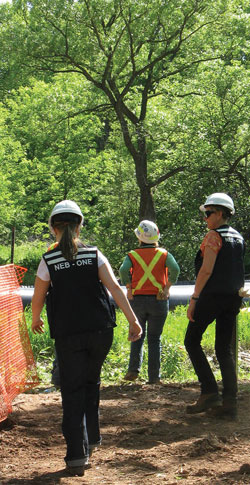
The safety of Canadians and protection of the environment in the construction, operation and abandonment of pipeline facilities regulated by the NEB are the Board’s top priorities, and have been a part of our mandate since 1959.
We regulate from "start" to "finish" and hold those we regulate accountable so that the safety of Canadians and the environment is protected. In order to deliver on its mandate, the NEB has regulations in place that set clear expectations for industry. The Board evaluates project proposals, monitors compliance and enforces rules. This framework places heavy emphasis on measuring performance and continual improvement, both by the NEB and its regulated companies.
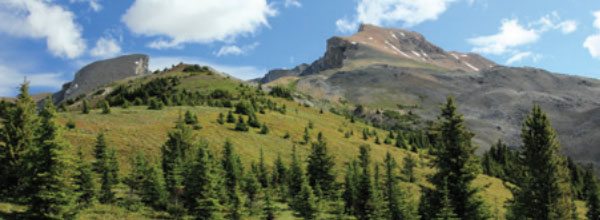
Fully Implemented: Action Plan on Safety and Environmental Protection
In 2011, the NEB created an Action Plan on Safety and Environmental Protection to improve outcomes in four strategic areas:
Worker Safety Proactive safety management and a culture of safety are values for industry |
Integrity of Installations Prevention of spills and releases is the focus of industry systems |
| Safety and Environmental Protection Outcomes | |
Damage Prevention Industry promotes awareness of safe work practices near pipelines and creates the conditions for the NEB to hold people accountable |
Emergency Preparedness and Response Systems are in place to minimize risk to people and the environment in the event of an emergency |
In June 2013, the Board completed all actions set out in the Safety Action Plan by convening a forum on pipeline and facility safety. The NEB is committed to continual improvement and will continue to take further action to improve results in the four pillars of safety and environmental protection outcomes.

Safety Forum 2013
The National Energy Board held its 2013 Safety Forum on June 5th and 6th in Calgary, Alberta. Over the course of the event, 20 speakers ranging from Chief Executive Officers to subject matter experts, presented information through panel discussions and keynote sessions. The Forum was attended by 385 participants representing the public, Aboriginal peoples, industry, consultants, academia, government, NEB representatives and youth.
Key topics discussed at the Forum included corporate leadership’s role in building and maintaining a safety culture, effectiveness of management systems and performance measurement’s role in risk management. Other areas explored were how industry can work to strengthen public trust, the role of energy sector leadership in safety, public expectations around transparency of information, and the evolving role of the regulator as it strives to continually improve in its role as Canada’s energy watchdog.
The NEB committed to taking concrete actions in order to move industry, and itself, forward in achieving the goal of zero incidents. This includes:
- Undertaking a public consultation on safety culture in order to develop clear definitions, attributes and indicators;
- Developing guidance to improve the prevention of catastrophic events;
- Improving how Canadians get the energy information they want and need; and
- Setting a path for continual improvement through collaboration with other regulators, and reporting on safety and enforcement tools the Board has recently implemented such as Administrative Monetary Penalties (AMPs).
A focus on safety culture is key to ensuring regulated companies meet their obligations.
Regulatory Coordination
International Regulators’ Forum
In October 2013, the NEB attended the International Regulators’ Forum’s (IRF)[5] biennial conference and meeting held in Perth, Australia, and was enrolled as a part of a reconstituted Canadian membership. The NEB represents Canada on a rotational basis with the Canada–Newfoundland and Labrador Offshore Petroleum Board and the Canada–Nova Scotia Offshore Petroleum Board. The NEB is providing its expertise for the advancement of understanding and awareness of the key role that safety culture plays in preventing major accidents across the industry. During the event the three Canadian Boards shared their Draft Safety Culture Framework with other IRF members receiving favourable feedback.
Working with Other Regulators
The NEB is an active member of the North American regulatory community, collaborating on regulatory practices, sharing findings and regulatory perspectives and providing information on industry trends. The NEB has MOUs with numerous agencies within the Provincial, Federal and International communities. The NEB is also a member of Canada’s Energy and Utility Regulators (CAMPUT). Currently, the NEB is working with Canada’s two Offshore Petroleum Boards to propose a common draft of a definition and framework for Safety Culture. The discussion paper, released in October, Advancing Safety in the Oil and Gas Industry: Draft Safety Culture Framework, is intended to promote learning and a shared understanding of the emerging discipline of Safety Culture across the oil and gas sector in Canada. This effort is intended to develop better aligned regulatory requirements to promote a strong safety culture in the oil and gas industry.
Safety Culture
Culture influences what people see, hear, feel, and say. Perhaps more importantly, it influences the decisions, actions and behaviours of people in an organization. These behaviours ultimately drive safety outcomes and performance.
A strong safety culture is one in which:
- leaders demonstrate that safety is their overriding value and priority;
- everyone is aware of known hazards while remaining vigilant to new threats;
- every employee feels empowered and rewarded for making safe decisions;
- employees feel encouraged to report safety hazards, including instances where they have committed an error and introduced a threat themselves;
- the most junior employee would not hesitate to take action in response to a safety concern without fear of disciplinary action or reprisal;
- the supervisor does not have to be present for someone to do the right thing; and
- the organization is continually learning from its own and others’ experiences with the goal of advancing safety.
Strong leadership is key to establishing, fostering and maintaining a healthy safety culture.
Strong leadership is key to establishing, fostering and maintaining a healthy safety culture. The attitudes of executive and senior management, their actions and decisions serve to shape corporate culture. Leadership uses its management systems’ policies, priorities, processes, and procedures to formally communicate its values and expectations. Through these mechanisms, executive management establishes the initial framework of the corporate culture. Where an organization is strongly in tune with establishing and maintaining a positive safety culture, it scrutinizes, as a normal business function, every decision to ensure that risk is considered and managed appropriately. The Board is committed to supporting safety culture. This was a key topic discussed during the Safety Forum in June 2013, as well as being the focus of the Board’s discussion paper Advancing Safety in the Oil and Gas Industry: Draft Safety Culture Framework.
Management Systems
Carefully designed and well-implemented management systems are essential to keep people safe and protect the environment. Management systems include the necessary organizational structures, resources, accountabilities, policies and procedures to effectively manage risks and continually improve operations.
An effective management system has elements to identify potential hazards, manage risks, train and supervise workers and contractors, communicate, manage records and documentation, monitor and evaluate progress, and continually improve performance. This provides a consistent framework for the cyclical planning, implementation, review and adjustment of operational activities, which is essential for a company to manage its human and financial resources appropriately to achieve desired safety outcomes.
The NEB has identified three outcomes for regulated companies: safety and security of the public and company employees; protection of the environment and property; and the safety and security of infrastructure.
The NEB has identified three outcomes for regulated companies: the safety and security of the public and company employees; the protection of the environment and property; and the safety and security of infrastructure.
A company’s management system should complement protection programs (integrity, safety, environmental protection, damage prevention, emergency management, and security) and should be proportionate to the size and risk of the assets being protected and activities performed. It is intended to be scalable, so that it can be used appropriately by both small operators and large companies.
Canadian Standards Association (CSA)
Through its Emergency Management (EM) Program, the NEB focuses on overseeing the EM programs of its regulated companies. Since April 2012, the NEB has been working with the Canadian Standards Association (CSA) and emergency management experts to draft a preparedness and response standard (CSA Z246.2 - Emergency preparedness and response for petroleum and natural gas industry systems). The standard is expected to be published in 2014. NEB staff also continue to participate on the CSA Z1600 (Emergency Management and Business Continuity Programs) Technical Committee. CSA Z1600 applies to public and private organizations of all sizes, and covers prevention, mitigation, preparedness, response and recovery.
In late 2012, the CSA proposed that a Damage Prevention Standard be developed for Canadian underground infrastructure. The Technical Committee for CSA Z247 - Damage Prevention for the Protection of Underground Energy and Utility Infrastructure was formed in February of 2013. The committee membership consists of the NEB, representatives of the oil and gas and construction industries, landowners, locators, one-call centres, and other governments, who all provide technical support in the development of the standard. This standard will outline the key elements (e.g. minimum requirements, guidance, and best practices) that, when consistently applied, will reduce damage to all buried infrastructure and significantly enhance public safety. The Draft Standard will also strive to meet public safety expectations.
The NEB continues to strongly support excellence in emergency management and damage prevention through direct participation of staff on standards development committees. NEB staff work with other stakeholders for the further enhancement and development of the standards within the Petroleum and Natural Gas Industry Pipeline Systems and Materials program. The standards include CSA Z662 (Oil and Gas Pipeline Systems) and CSA Z246.1 (Security management for petroleum and natural gas industry systems).
Monitoring Compliance
In 2012, as part of the Jobs, Growth and Long-term Prosperity Act, Parliament provided the NEB with an additional $13.5 million to hire more staff, increase the number of annual inspections for regulated companies from 100 to 150, and double the number of comprehensive audits from three to six. These measures provide the NEB with additional "boots on the ground" to verify the pipelines we regulate are operating safely.
Compliance Verification Activities (CVA)
The NEB monitors compliance through risk-informed verification activities, including concerns identified through the investigation of incidents and from the public. Legal requirements include Acts, regulations, standards adopted into regulation, directives and orders of the Board, and conditions of certificates and orders. The Board uses CVAs to verify that all known non-compliances have been corrected and to gather new information about the state of compliance in a specific area of a company’s operations or to investigate whether the NEB’s regulated companies are taking the appropriate preventive or corrective actions. The Board’s suite of CVAs includes:
- inspections[6] (of facilities under construction or in operation);
- evaluations of emergency exercises;
- reviews of emergency procedures manuals;
- compliance meetings (to check the progress of programs or corrective actions);
- audits[7]; and
- reviews of post-construction monitoring reports.
In 2013, the NEB conducted a total of 299 compliance activities related to security, public safety and environmental protection as seen in Table 1.
| Compliance Activity | Completed |
|---|---|
| Inspections: | |
| Safety | 48 |
| Integrity | 30 |
| Environmental | 70 |
| Security | 6 |
| Damage Prevention | 15 |
| Subtotal: | 169 |
| Emergency | 13 |
| Emergency Procedures Manual Review | 22 |
| Compliance Meetings | 69 |
| Audits | 4 |
| Report Reviews | 22 |
The NEB has significantly increased its compliance verification activities as a way to ensure companies are demonstrating a commitment to safety. As a result of the Jobs, Growth and Long-term Prosperity Act, we doubled the number of audits we do, and increased inspections from 100 to 150. In 2013 we completed four audits, and 169 inspections.
Enforcement Actions
The Board’s objective for enforcement actions is to achieve compliance as quickly and as effectively as possible. Achieving compliance reduces hazards and protects the safety of workers and the public, the environment and property. The NEB’s guiding enforcement policy statement is the following:
The NEB will enforce regulatory requirements to obtain compliance, deter future non-compliance, and prevent harm by using the most appropriate tool or tools available.
NEB enforcement tools are not mutually exclusive and more than one measure may be employed to obtain compliance, deter future non-compliance or to prevent incidents/accidents. When safety, security or environmental protection issues are identified, the NEB will use the most appropriate and efficient enforcement tool, including issuance of a Notice of Non-Compliance (NNC), Inspection Officer Order (IOO), Safety Order, AMPs, or taking the matter forward for Prosecution, or Revoking the Authorization.
The Board has taken the following types of enforcement actions in 2013:
- 283 Notices of Non-Compliance (NNC)[8] and Assurances of Voluntary Compliance (Canada Labour Code-related issues);
- 8 Inspection Officer Orders (IOO);
- 16 Safety Orders;
- 0 AMPs;
- 0 Revoked Certificates; and
- 0 Prosecutions Sought.
The most common findings of non-compliance were in the areas of sediment and erosion control/containment; and inadequate labelling/signage or site clean-up. In one instance, as an example, the Board issued an NNC when environmental inspections identified reclamation and site clean-up as issues following a company’s operation and maintenance activities.
While the Board always investigates issues with respect to its regulated companies, to date, the NEB has not had to use AMPs, revoke a certificate or prosecute a regulated company in order to obtain compliance with its acts and regulations. This outcome is consistent with the Board’s objective for gaining compliance as quickly and effectively as possible.
We have new enforcement tools that took effect in 2013 that will help obtain compliance with Board Orders, deter future non-compliance or prevent incidents/accidents.
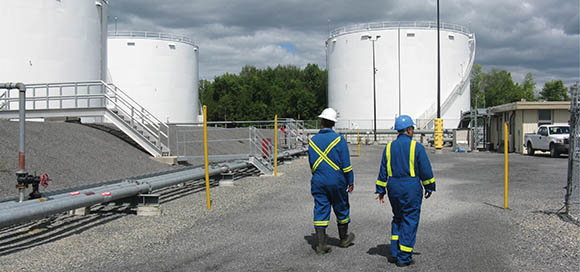
Safety Orders
The NEB enforces regulatory requirements using the most appropriate tool or tools available, such as Safety Orders, in order to obtain compliance, deter future non-compliance, and prevent harm. The NEB publishes compliance and enforcement documents on its website.
Described in the following table, the 16 Board Safety Orders issued in 2013, were used to impose preventative measures to ensure the safety of workers and the public and/or to protect property and the environment.
The NEB makes all compliance and enforcement actions public.
| Safety Orders | ||
|---|---|---|
| Company | Description | Order / Direction Date |
| NOVA Gas Transmission Ltd. (NGTL) | To verify that there is an adequate level of safety and security for the public and of the pipeline operating system, company required to conduct an engineering assessment demonstrating the pipeline is fit for service at the intended maximum operating pressure (MOP) of 8,450 kPa. The line is deactivated and may be abandoned in the future. | 10 January 2013 |
| Enbridge Pipelines (NW) Inc. | To ensure additional pressure restriction remained in place until the fitness for service of the pipeline is confirmed. | 08 March 2013 |
| Enbridge Pipelines Inc. | To address non-compliances with CSA Standard Z662-11 and with the OPR at its pump stations, company is directed to file a corrective action plan (CAP) related to emergency shutdown systems at pump stations by 15 April 2013. The CAP was approved 2 May 2013. Resolution of the issue is scheduled for 2014. | 14 March 2013 |
| Enbridge Pipelines (NW) Inc. | Due to four crude oil releases, company is directed to complete additional engineering assessment on the Wrigley to Mackenzie segment of Line 21, and submit an assessment of the currently available leak detection technologies to determine which is most applicable to Line 21 with a plan outlining the implementation for the selected technology. | 22 March 2013 |
| DR Four Beat Energy Corp. | Issued to suspend the operation of the Knappen Border Pipeline because company had no Emergency Procedures Manual or Emergency Response Plan. Board Order was filed in Federal Court as the company remains in violation of Board Order. | 18 April 2013 |
| Enbridge Pipelines Inc. | Issued to lift SO-E101-04-2010, as the company has met all requirements imposed by Order. | 16 May 2013 |
| Enbridge Pipelines Inc. | Line 6B rupture incident at Marshall, Michigan prompted Edmonton Control Room Inspection. Amending Order issued to clarify the effective date for the timing of filing for Condition 3.6. | 16 May 2013 |
| Enbridge Pipelines Inc. | Investigation into two overpressure incidents at the Edmonton Terminal made the Board aware that, in certain cases, company did not know the pressure rating of components in its system and overpressure protection system capabilities were not satisfactory under all possible operating scenarios. | 23 May 2013 |
| Enbridge Pipelines Inc. | Order issued to clarify the effective date of Safety Order SO-E101-003-2013. | 17 June 2013 |
| Imperial Oil Resources Ltd. | Order issued under the Canada Oil and Gas Operations Act to direct the company to submit a CAP related to flowline leaks of oil emulsion identified on four pipelines in the Norman Wells region. Company is also required to submit details of the interim mitigation measures that company has taken, or will take, to reduce the risk of a spill until the CAP is fully implemented. Company was also directed to submit a quarterly report regarding its progress in implementing the CAP. | 19 July 2013 |
| Kinder Morgan Canada Inc. | Pressure restriction to 80 per cent of Maximum Operating Pressure imposed due to incidents stemming from cracking features. | 2 August 2013 |
| Trans-Northern Pipelines Inc. | Issued to Partially Lift Safety Order SO-T217-03-2010, Montreal to Farran’s Point. | 29 August 2013 |
| TransCanada PipeLines Limited | Due to nine incidents involving a fire or explosion of batteries, company is required to file its current procedure to investigate incidents, an explanation of the root cause of the battery explosions, and specific related technical procedures. | 29 August 2013 |
| NOVA Gas Transmission Ltd. | Due to a leak on NPS 24 North Lateral Extension Loop and the engineering assessment not meeting CSA Z662-11 standards, two pressure reductions were ordered. | 19 December 2013 |
| NOVA Gas Transmission Ltd. | Due to a leak on the NPS 6 Ukalta Lateral, Order was issued directing company to: 1) restrict the operating pressure of the leaked section; 2) perform above-ground leak detection surveys; 3) file company’s findings related to features that are identified; 4) provide a corrosion condition monitoring plan; 5) conduct an Engineering Assessment prior to increasing the operating pressure; and 6) provide notification with a rationale if company decides to further de-rate the pipeline’s reduced operating pressure. | 19 December 2013 |
| NOVA Gas Transmission Ltd. | Due to two leaks on the NPS 8 Mitsue Lateral, Order was issued directing company to: 1) restrict the operating pressure of the leaked pipeline; 2) perform above-ground leak detection surveys; 3) file company’s findings related to features that are identified; 4) file a corrosion condition monitoring plan; 5) conduct an Engineering Assessment prior to increasing the operating pressure; and 6) provide notification with a rationale if company decides to further de-rate the pipeline’s reduced operating pressure. | 19 December 2013 |
Reportable Incidents
A company must immediately notify the NEB of any incident that relates to the construction, operation or pending abandonment of its pipeline.
The National Energy Board Onshore Pipeline Regulations (OPR) defines an "incident" as:
- an unintended or uncontained release of low vapour pressure (LVP) hydrocarbons (which refers to hydrocarbons in a liquid form) in excess of 1.5 m³;
- an unintended or uncontrolled release of gas or high vapour pressure (HVP) hydrocarbons;
- the death or serious injury[9]to a person;
- a significant adverse effect on the environment;
- an unintended fire or explosion; or,
- the operation of a pipeline beyond its design limits as determined under Canadian Standards Association (CSA) Z662 or CSA Z276 or any operating limits imposed by the Board[10].
The Board’s regulated companies are accountable for anticipating, preventing, and mitigating and managing all reportable incidents. Any incident is considered unacceptable by the Board and the Board follows up on all incidents.
In 2013, there were 97[11] reportable incidents compared to 134 in 2012.
There is a 28 per cent decrease in the number of incidents this year over last year.
Figure 2 shows the total number of reportable incidents under the OPR for the past five years.
Figure 2 - Number of Incidents, 2009-2013
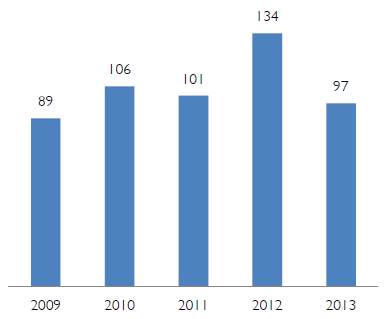
The year over year change in the number of incidents from 2012, by type, is shown in Figure 3. Most reportable incidents do not result in threats to the safety of people or the environment. All incidents provide the Board with invaluable information called "leading indicators" that aid the Board in identifying and proactively preventing more serious problems in the future. A more detailed discussion of all OPR incidents follows.
Figure 3 - Number of Incidents by Type, 2012 vs. 2013
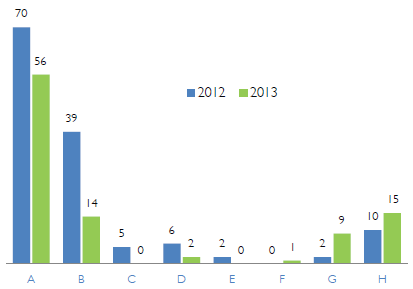 Natural Gas and Other HVP Releases
Natural Gas and Other HVP Releases- Fires
- Explosions
- Serious Injuries
- Significant Adverse Effects on the Environment
- Fatalities
- Liquid Releases
- Operation Beyond Design Limits
The NEB is committed to working with companies and other stakeholders to find ways to improve safety performance in order to meet the target of zero incidents.
Pipeline Releases
Pipeline safety and the protection of the environment are top of mind for Canadians. The Board has observed an increase in the number of LVP (liquid) releases this past year, from two in 2012 to nine in 2013, however the total volume of releases has significantly declined as shown in Figure 4. There have been a total of 31 liquid releases since 2009.
Figure 4 - Total Volumes of Liquids Released Vs. Number of Liquid Releases
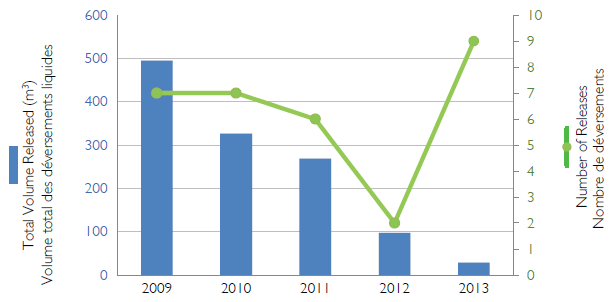
Liquid hydrocarbon spills can be a significant hazard to people and the environment if uncontained. In recent years, the NEB has significantly increased its compliance verification activities in pursuit of its goal of zero incidents. In 2013, the Board completed four audits and 169 inspections on pipeline systems. The NEB also clarified its enforcement policy and increased the number of enforcement actions it has taken. Numerous Board Orders and Letters of Direction have been imposed on companies to ensure swift and effective action on non-compliances.
These Board actions have directly affected how companies are operating their pipelines and the way companies are approaching the safety of their systems and the results are moving in the right direction. There has been a decreasing trend in the volume of liquid hydrocarbon spilled from NEB-regulated pipelines since 2009. In 2013, nearly all liquid releases from NEB-regulated energy facilities have been fully remediated. The exceptions are those where cleanup is underway. This data shows that the Board and industry are on the right path to continuously improve outcomes in safety and environmental protection.
Who is discovering pipeline releases is an important question. The Board requires companies to manage and carefully monitor their systems and as a result should be the first to detect any inconsistency in their operations. Over the five-year period from 2008 to 2013, 92 per cent (37) of releases were reported by the regulated company or one of their contractors, five per cent (two) were reported by landowners and three per cent (one) were reported by members of the public. In 2013, 100 per cent of releases were reported by companies.
Every release that is 1.5 m³ or greater is reported to the Board. The number of low-vapour pressure (liquid) pipeline releases increased in 2013, but the volume averages have gone down significantly since 2009.
The number of high vapour pressure (gas) pipeline releases have decreased.
The nine LVP releases in 2013 were all between the minimum reportable threshold of 1.5 m³ (as set out in the OPR) and 100 m³. There has not been a spill greater than 100 m³ since 2011. One of the releases occurred on the pipeline right-of-way, and was discovered while the reporting company was undertaking an integrity dig. The other eight releases occurred on station property and were fully contained. The products released in 2013 included crude oil, condensate and other products (e.g. lube and heating oil).
The majority (approximately 90 per cent) of HVP (gas) releases in 2013 involve sweet natural gas. There has been an overall decrease in the number of HVP product releases from 2012 to 2013, down from 70 to 56. Figure 5 shows the number of HVP and natural gas releases from 2009-2013.
Figure 5 - Number of Natural Gas and Other High Vapour Pressure Releases
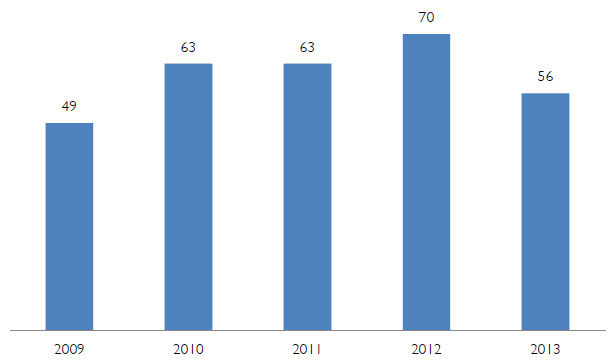
The Board’s enhanced regulatory requirements and actions are driving increasing diligence on the part of companies in the monitoring of their facilities. This diligence on both sides will lead towards the goal of zero incidents.
Death or Serious Injury to a Person
The safety of those who build and operate energy infrastructure regulated by the NEB is of paramount importance to the Board. In 2013, there were two serious injuries and one fatality. One serious injury incident involved burns due to the ignition of gas when a pipe was being welded, and the second resulted from a vehicle rollover. The same vehicle rollover also resulted in a fatality incident. In the last five years, fatalities have averaged one per year, and are mainly related to the use of motorized vehicles off the pipeline right-of-way (RoW). The NEB is working with companies to resolve this safety concern. As a result, companies are focusing their training on ensuring people get home safely as part of ongoing safety culture work.
There has been a decline in serious injuries - although there was one fatality in 2013 due to a vehicle rollover. Worker safety is of paramount importance to the Board and any fatality or serious injury is considered unacceptable.
Unintended Fires / Explosions
This year there were 14 fires and no explosions, down from 39 fires and five explosions in 2012. The reported explosions in 2012 all involved batteries exploding, causing either small fires or smoke, or the release of battery acid within company property. Prior to 2013, the Board observed an increase in the number of fires and explosions. These incidents, including those in 2013, are mainly the result of the following issues: equipment and electrical failures, battery-related explosions, welding, housekeeping (e.g. unorganized workspaces) and natural events (e.g. lightning strikes). Several incidents in 2013 remain open and are under investigation, therefore causes have not yet been determined.
Unintended fires have decreased in frequency and there were no explosions.
Figure 6 shows the frequency of fires and explosions over the past five years.
Figure 6 - Number of Fires and Explosions, 2009-2013
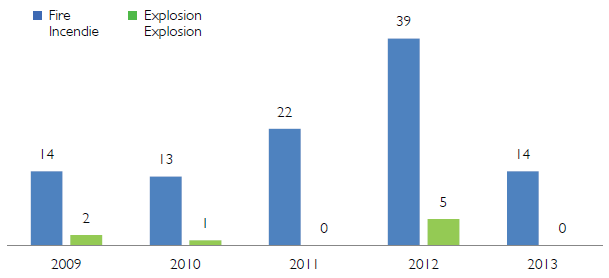
It is important to note that while the majority of these incidents are considered minor in nature, meaning an incident that has been contained and/or is small, the NEB takes them quite seriously and has taken actions to further prevent future incidents. The Board’s CVAs this year included activities, such as safety orders, audits and subsequent inspections, to address the trend in fires and explosions.
Operation Beyond Design Limits
In 2013, there were 15 "operation beyond design limits" incidents reported to the Board. These types of incidents include events such as overpressures, vibration beyond design limits, slope movements, and introduction of an inappropriate product (e.g., sour gas in excess of CSA limits). Of the 15 incidents this past year, 12 were related to overpressures, two were due to inappropriate product entering the system and one was due to slope movement.
In April 2012, the Board issued a Safety Advisory to all its regulated companies (NEB-SA-2012-01) which provided information on preventive actions for operation beyond design limits of their energy infrastructure. The Board follows up on every incident that is reported. Due to several overpressure incidents, the Board issued a Safety Order to Enbridge Pipelines Inc. in 2013. The NEB, based on its follow-up, will continue to monitor and take action as appropriate.
Operation beyond design limits has increased. The Board is monitoring this and has taken a number of measures to reduce this number in the future.
Operation and Maintenance (O&M) Activities - Integrity Digs
Companies are required to notify the Board in advance of certain O&M activities under the Regulation of Operations and Maintenance Activities on Pipelines under the NEB Act. The criteria for notifying the Board include:
- physical removal and replacement of greater than 100 m of pipe,
- notification to the Board of third party concerns
- any activity that causes pipeline exposure
- when new permanent land must be acquired
- pressure testing (other than hydrostatic testing), and/or
- ground disturbance within 30 m of a wetland or water body.
Since 2010, there has been an increase in the number of O&M activities, partially as a result of Safety Orders issued by the Board in 2010 and 2011.
Figure 7 presents the total number of O&M activities for Group 1 and 2 oil, natural gas and NGL companies, for the period 2009 through 2013.
Figure 7 - Total Operations & Maintenance Activities
(Including Integrity Digs)

Although this data only includes O&M activities where advance notification is required, it is clear that companies are conducting more O&M activities and, therefore, are looking more closely at their pipelines. This increased activity is being driven in part by the increase in Safety Orders issued by the Board requiring better investigation of pipeline anomalies, as well as the need to justify to the Board in applications that existing pipe is fit for service under modified operating conditions. In addition, companies are taking more accountability to prevent incidents, improving their management systems and safety culture.
Incidents Under COGOA and Associated Regulations
The NEB also has regulatory responsibilities for oil and gas exploration and production activities under the Canada Oil and Gas Operations Act (COGOA). These include responsibilities for frontier lands that are not otherwise regulated under joint federal/provincial accords - and include Northwest Territories, Nunavut, Arctic offshore, Hudson Bay, West Coast offshore, Gulf of St. Lawrence, a portion of the Bay of Fundy and onshore Sable Island.
The regulation under COGOA defines "incident" as:
- any event that causes a lost or restricted workday injury, death, fire or explosion, a loss of containment from a well, an imminent threat to the safety of a person, installation or support craft, or pollution;
- any event that results in a missing person; or
- any event that causes the impairment of any structure, facility, equipment or system critical to the safety of persons, an installation or support craft, or the impairment of any structure, facility, equipment or system critical to environmental protection.
Under COGOA, energy facility operators are required to report all incidents to the Board, investigate each incident, identify root causes and factors, and take corrective actions. For all incidents that result in a loss of containment of fluid from a well/pipe, the operator is required to provide a copy of the investigation to the Board.
In 2013, 19 incidents were reported to the Board under COGOA:
- Release of product accounted for 11 incidents. All but one of the releases was less than 1 m³, one incident was 12 m³. Furthermore, all of the product released has been completely recovered or is in the process of being recovered - with full recovery expected;
- Fire accounted for three incidents;
- Serious injury accounted for three incidents; and
- Other event (e.g. power interruption/equipment failure) accounted for two incidents.
The five year trend of COGOA incidents is shown in Table 8.
| Year | Number of Incidents |
|---|---|
| 2009 | 19 |
| 2010 | 9 |
| 2011 | 26 |
| 2012 | 15 |
| 2013 | 19 |
The NEB has followed up on all incidents reported to it under this Act. As per COGOA, companies must undertake measures to prevent future incidents, repair or remedy any condition resulting from an incident, and take steps to reduce or mitigate any danger to life, health, the environment or property. The NEB will not consider clean-up to be complete until it is satisfied that there has been full remediation of the site of all environmental effects.
Damage Prevention and Unauthorized Activities (UA)
Unauthorized Activities (UA)
Unauthorized Activities[12] fall under the Board’s Pipeline Crossing Regulations and include an excavation or construction activity for which the appropriate permission is required and not obtained, or when safety instructions are not followed.
If there is an incident, the NEB takes direct and immediate action to manage, monitor and communicate so that people have the information they need to stay safe and respond to any emergency.
In 2013, there were 113 reported unauthorized activities related to NEB-regulated facilities, down from 144 in 2012. Figure 9 shows all UAs by type for 2010 to 2013.
Figure 9 - Number of Unauthorized Activities by Type, 2010-2013

The data indicates that ground disturbance, or excavation activities, is the most prevalent UA. Encroachment activities generally consist of stockpiling fill or sand, and building sheds, skating rinks or above ground pools on the pipeline right-of-way. Vehicle crossing refers to vehicles or construction equipment operating on or across the right-of-way without permission.
Everyone involved must work to reduce unauthorized activities, with the ultimate goal of seeing none at all. The number of reported unauthorized activities fluctuates from year to year due to a number of factors. The number may grow as development and construction activity increases around pipelines. Unsafe excavation and construction practices can cause damage and put the safety of people and the environment at risk. Focused compliance and enforcement activities by the NEB have increased awareness and compliance for companies with respect to reporting requirements. Knowing where to "dig" and how to do it safely, are important subjects as everyone must work together to reduce UAs.
NEB’s Response During the Southern Alberta Flood
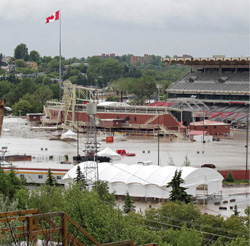
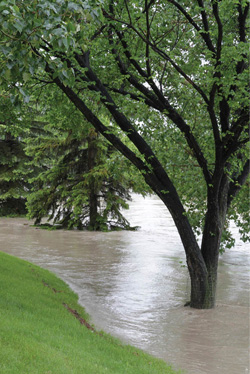 During the flooding in Southern Alberta in 2013, the National Energy Board actively monitored the impacts of flooding on its regulated pipelines. While some pipelines were exposed due to erosion or rerouting of waterways, affected companies continued to monitor their pipeline systems. Where required, companies took appropriate action to manage and mitigate any potential risks associated with the exposed pipelines.
During the flooding in Southern Alberta in 2013, the National Energy Board actively monitored the impacts of flooding on its regulated pipelines. While some pipelines were exposed due to erosion or rerouting of waterways, affected companies continued to monitor their pipeline systems. Where required, companies took appropriate action to manage and mitigate any potential risks associated with the exposed pipelines.
There were no product releases on any NEB-regulated pipelines as a result of the flooding.
The NEB’s commitment to safety extends beyond operational safety in the energy sector. During the flooding, the NEB activated its business continuity plan to ensure service to Canadians was not interrupted. The NEB updated staff with timely safety communications using multiple media sources. It also facilitated and supported volunteer opportunities to assist affected staff and members of the community with flood relief efforts.
Canadian Common Ground Alliance
As the Federal Regulatory Champion for the Canadian Common Ground Alliance (an organization dedicated to pipeline damage prevention solutions), the NEB is collaborating with the pipeline and digging communities in promoting safe work practices around pipelines. In addition to regulatory initiatives to clarify the roles and responsibilities of everyone involved, the NEB commenced work on a national standard for damage prevention in 2013. Further information regarding the CSA Z247 Standard (Damage Prevention for the Protection of Underground Energy and Utility Infrastructure) is included in the CSA Standards section of this report.
Emergency Management
When the NEB is notified of an incident, the top priority is safety and security of people, and protection of property and the environment. The Board has a comprehensive Emergency Management Program, which can include a field response. Further, we will verify that a regulated company conducts an adequate and appropriate clean-up and remediation of any environmental effects resulting from the incident.
NEB staff conducted on-site responses to the following seven incidents in 2013. These incidents were:
- A power interruption at Imperial Oil Resources NWT Ltd.’s Norman Wells production facility, impacting the town of Norman Wells, NT.
- A fire and injury at a Westcoast Energy Inc. facility near Fort Nelson, BC. The incident occurred during a valve replacement on a depressurized section of pipe and a mud plug let go.
- A failure of downhole injection well equipment in a storage cavern at the Plains Midstream Canada ULC terminal at Windsor, ON. There was no off-site release, no environmental damages, no injuries and the hydrocarbon release was immediately contained.
- A hydrocarbon release occurred on a multi-company right-of-way near Sarnia, ON. The Board responded, but it was subsequently determined that the release occurred from an adjacent pipeline under provincial jurisdiction. The Board aided the provincial regulator in securing the site.
- A hydrocarbon release was detected during an integrity dig on Trans Mountain Pipeline ULC’s Mainline pipeline near Merritt, BC. The release was contained within the right-of-way and the line was shut down. The release did not result in a fire, injuries or impacts to the environment. The estimated volume of oil released was approximately 0.8 m³.
- A hydrocarbon release was detected during an integrity dig on Trans Mountain Pipeline ULC’s Mainline pipeline near Hope, BC. The Board has noted that there was some subsurface contamination, and impacts to groundwater are being assessed in detail. The release did not result in a fire, injuries or impacts to the environment. The estimated volume of oil released was approximately 4 m³.
- A rupture occurred on Nova Gas Transmission Ltd.’s North Central Corridor pipeline near a remote area west of Fort McMurray. An Inspection Officer Order was issued placing a pressure restriction limit until the company provides an engineering assessment to the Board demonstrating that the pipeline can be operated safely. The incident did not result in any injuries, or environmental impacts.
Our compliance and enforcement activities are directed to the early identification of hazards, in order to both avoid incidents and minimize related safety and environmental impacts.
Environmental Protection
 Making sure the right safety measures are in place and taking the appropriate enforcement actions are key to protecting the environment. The Board has approximately 60 environmental staff with expertise in environmental protection including:
Making sure the right safety measures are in place and taking the appropriate enforcement actions are key to protecting the environment. The Board has approximately 60 environmental staff with expertise in environmental protection including:
- physical and meteorological environment;
- soil, soil productivity and vegetation;
- wetlands, water quality and quantity;
- fish, wildlife, and their habitat;
- species at risk or species of special status and related habitat;
- heritage resources;
- traditional land and resource use; and
- human health, aesthetics and noise.
 Companies planning to build energy facilities are required to satisfy the Board that they have anticipated all possible environmental issues. The NEB conducts an environmental assessment during its review of applications for projects under its jurisdiction. The Board will also audit and inspect a company’s activities including routine maintenance and monitoring procedures over the lifecycle of an energy project. We do this in order to verify compliance of regulatory requirements and any conditions imposed.
Companies planning to build energy facilities are required to satisfy the Board that they have anticipated all possible environmental issues. The NEB conducts an environmental assessment during its review of applications for projects under its jurisdiction. The Board will also audit and inspect a company’s activities including routine maintenance and monitoring procedures over the lifecycle of an energy project. We do this in order to verify compliance of regulatory requirements and any conditions imposed.
The Board has approximately 60 environmental staff with expertise in environmental protection.
CEAA 2012 - Report on Activities
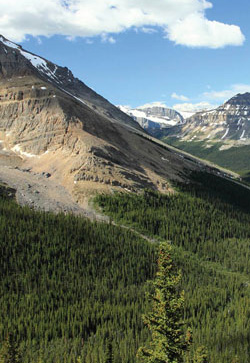 For projects located on federal lands[13], section 67 of the Canadian Environmental Assessment Act 2012 (CEAA 2012) requires that before federal authorities make any decision that would allow a project to proceed, they must determine whether a project is likely to cause significant adverse environmental effects. Under section 71 of the CEAA 2012, the NEB is required to, at the end of each fiscal year, report to each House of Parliament on its activities under sections 67, 68 and 69 of the CEAA 2012 during the previous fiscal year.
For projects located on federal lands[13], section 67 of the Canadian Environmental Assessment Act 2012 (CEAA 2012) requires that before federal authorities make any decision that would allow a project to proceed, they must determine whether a project is likely to cause significant adverse environmental effects. Under section 71 of the CEAA 2012, the NEB is required to, at the end of each fiscal year, report to each House of Parliament on its activities under sections 67, 68 and 69 of the CEAA 2012 during the previous fiscal year.
During the fiscal year 2012-2013, the NEB completed the environmental assessment for one project, a section 58 application from Black Pearl Resources to construct and operate Central SK-AB PW Disposal Pipeline that would cross federal lands. The project involved the construction of 100 metres of pipeline to transport produced water from existing and proposed production and gathering facilities in Saskatchewan to an existing produced water disposal well in Alberta. Of the total length of the pipeline, 50 metres of the produced water pipeline crossed the Onion Lake Indian Reserve. The NEB determined that the carrying out of this project was not likely to cause any significant adverse environmental effects and approved the project.
Memorandum of Understanding with Department of Fisheries and Oceans
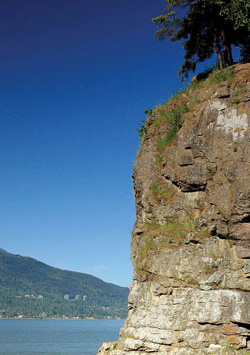 On 16 December 2013 the NEB entered into a Memorandum of Understanding (MOU) with the Department of Fisheries and Oceans (DFO) whereby the Board will review project applications to determine if a Fisheries Act authorization will be required. These two measures implement "one-window" regulatory oversight for safety and environmental protection of watercourse crossings by the Board. The NEB is best positioned to deliver regulatory review responsibilities under the Fisheries Act for activities related to federally regulated energy infrastructure. Environmental aspects have been considered in Board decisions / recommendations under the NEB Act since the early 1970’s, and we have been conducting environmental assessments under CEAA since it first came into force in 1995. This MOU does not impact the NEB’s capabilities as fish and fish habitats have been taken into account as part of our environmental review process for over 40 years. As a result, we have the expertise required to assess potential impacts. Furthermore, should any aquatic species listed under the Species at Risk Act be present in any of the watercourses to be crossed by an energy facility, DFO will be notified as the competent authority to allow for their participation in the Panel process.
On 16 December 2013 the NEB entered into a Memorandum of Understanding (MOU) with the Department of Fisheries and Oceans (DFO) whereby the Board will review project applications to determine if a Fisheries Act authorization will be required. These two measures implement "one-window" regulatory oversight for safety and environmental protection of watercourse crossings by the Board. The NEB is best positioned to deliver regulatory review responsibilities under the Fisheries Act for activities related to federally regulated energy infrastructure. Environmental aspects have been considered in Board decisions / recommendations under the NEB Act since the early 1970’s, and we have been conducting environmental assessments under CEAA since it first came into force in 1995. This MOU does not impact the NEB’s capabilities as fish and fish habitats have been taken into account as part of our environmental review process for over 40 years. As a result, we have the expertise required to assess potential impacts. Furthermore, should any aquatic species listed under the Species at Risk Act be present in any of the watercourses to be crossed by an energy facility, DFO will be notified as the competent authority to allow for their participation in the Panel process.
Energy Infrastructure
Today and Tomorrow
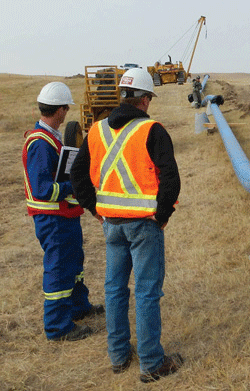 Canadians depend on the pipeline transportation system for a safe, reliable and efficient energy supply, now and in the future. The ability of this system to deliver natural gas, natural gas liquids (NGLs), crude oil, and petroleum products is also critical to Canada’s economy. The NEB is active and effective in Canada’s pursuit of a sustainable energy future by integrating at the same time relevant economic, environmental and social considerations when choosing a course of action.
Canadians depend on the pipeline transportation system for a safe, reliable and efficient energy supply, now and in the future. The ability of this system to deliver natural gas, natural gas liquids (NGLs), crude oil, and petroleum products is also critical to Canada’s economy. The NEB is active and effective in Canada’s pursuit of a sustainable energy future by integrating at the same time relevant economic, environmental and social considerations when choosing a course of action.
The NEB provides Canadians with the information they need to make informed energy decisions.
The NEB’s regulatory framework is designed to promote safety, security, environmental protection and efficient energy infrastructure and markets. Requirements encourage innovation where possible but also specify mandatory design, operational practices or management methods when necessary. The regulatory framework supports a sustainable energy system that will meet Canadians’ needs today, while taking into consideration the needs of Canadians tomorrow.
The NEB’s regulatory framework is designed to promote safety, security, environmental protection and efficient energy infrastructure and markets.
Full Cycle Regulation
The NEB regulates and considers issues of design, construction, operation and abandonment of energy infrastructure facilities. In other words, the Board regulates from "start to finish", and holds pipeline companies responsible for the full life cycle of the pipelines they operate.
The NEB regulates pipelines from "start to finish".
In May 2009, the NEB released a decision directing all NEB-regulated companies to begin setting aside abandonment funds and set out a five-year Action Plan in that regard. The five-year Action Plan contains steps which will facilitate the setting-aside and reporting on funds by 2015.
The five-year Action Plan is on track. In November 2011, all large regulated pipeline companies and many smaller ones filed their initial estimates of costs to abandon their pipelines. On 14 February 2013, the NEB approved the abandonment cost estimates of 12 of the 13 large regulated pipeline companies as filed, subject to numerous directions specific to each company. One large company, Maritimes & Northeast Pipeline Management Ltd., was not a part of this process because it followed the NEB’s previously released base case for abandonment cost estimates and therefore did not require Board approval. The NEB will hold an oral hearing in early 2014 with respect to how abandonment-related funds will be collected and how the funds will be set-aside and managed by "Group 1"[14] and "Group 2"[15]companies.
The NEB is working to make sure all companies have mechanisms in place to deal with the potential costs of abandonment so that all projects are managed appropriately.
Applications and Hearings in 2013
Companies regulated by the NEB are required to seek the Board’s approval to, among other things:
- construct and operate international and interprovincial pipelines and international power lines in Canada, along with related facilities and activities, or modify or abandon existing facilities;
- export crude oil, natural gas liquids and electricity, and export and import natural gas; and
- establish pipeline tolls and tariffs.
| 2012 | 2013 | |
|---|---|---|
| Section 52[16] | 1 | 3 |
| Section 58[17] | 35 | 41 |
| Part VI Import/Export | 426 | 412 |
| Traffic, Tolls and Tariffs | 21 | 18 |
| Abandonment | 1 | 5 |
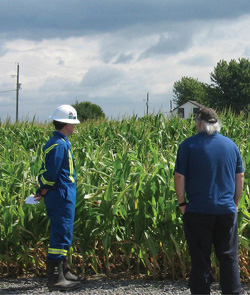 For a large facilities application, the Board’s work begins when a company files a Project Description. The NEB uses a Project Description to initiate pre-application activities. These include early public and Aboriginal engagement processes; and initiating the NEB’s Participant Funding Program for the project.
For a large facilities application, the Board’s work begins when a company files a Project Description. The NEB uses a Project Description to initiate pre-application activities. These include early public and Aboriginal engagement processes; and initiating the NEB’s Participant Funding Program for the project.
We engage the public and Aboriginal groups who may be directly impacted by a project through the Board’s engagement staff (Process Advisors - see "In the Public Interest" section for more detail on their role), who provide support to hearing participants, engage stakeholders, and share information about Appropriate Dispute Resolution, hearing processes, participant funding and methods of presenting information to the Board.
We engage the public and Aboriginal groups who may be impacted by a project.
 Companies applying to the Board (Applicants) must submit applications or information that enable the Board to undertake a technical assessment of the various impacts of a project, and make an informed recommendation or decision in the Canadian public interest that considers, among other things, present and future economic, environmental and social considerations. A written or oral hearing is usually held to consider applications for major projects[18]. This allows the company proposing the project, and people or groups who are directly impacted, a chance to provide information and input.
Companies applying to the Board (Applicants) must submit applications or information that enable the Board to undertake a technical assessment of the various impacts of a project, and make an informed recommendation or decision in the Canadian public interest that considers, among other things, present and future economic, environmental and social considerations. A written or oral hearing is usually held to consider applications for major projects[18]. This allows the company proposing the project, and people or groups who are directly impacted, a chance to provide information and input.
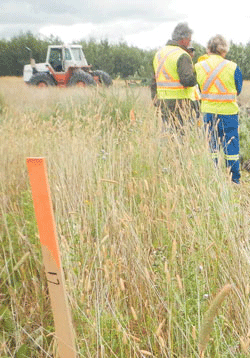 When the Board issues a certificate following the Governor in Council (GiC) approval of a large facility application, the approval is contingent on meeting conditions, which are requirements that must be met before a facility is allowed to be constructed and/or operated. Conditions pertain to areas such as engineering, engagement, safety and environmental protection. The Board holds the company accountable to conditions outlined in the certificate. If the project is built, the NEB will monitor the project throughout its lifespan, and require the certificate holder to meet these conditions, as well as other applicable regulatory requirements.
When the Board issues a certificate following the Governor in Council (GiC) approval of a large facility application, the approval is contingent on meeting conditions, which are requirements that must be met before a facility is allowed to be constructed and/or operated. Conditions pertain to areas such as engineering, engagement, safety and environmental protection. The Board holds the company accountable to conditions outlined in the certificate. If the project is built, the NEB will monitor the project throughout its lifespan, and require the certificate holder to meet these conditions, as well as other applicable regulatory requirements.
For a complete list of the proceedings before the Board in 2013, please see Appendix A and Appendix B.
Any person dissatisfied with a Board decision can ask the Board to review the matter or seek redress from the courts. For a list of these proceedings, see Appendix C.
For a list of certificates and orders issued for oil and gas facilities, please see Appendix D and Appendix E respectively.
For more information on the Board’s financial statements, see Appendix F.
Decisions and Recommendations Issued in 2013 Include the Following:
Facilities
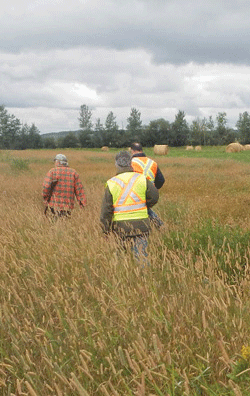 Northwest Mainline Komie North Extension Project
Northwest Mainline Komie North Extension Project
This was the first application following the legislative changes to the NEB Act, as a result of the Jobs, Growth and Long-term Prosperity Act. On 30 January 2013, the NEB recommended partial approval to the Governor in Council (GiC) for the Northwest Mainline Komie North Extension Project submitted by NOVA Gas Transmission Ltd (NGTL). The Board recommended approval for the Chinchaga section of the Project, which will expand the capacity of the Alberta System with a 33-km pipeline loop located in northwestern Alberta. The NEB did not recommend approval for the Komie North section which, would have been a 97-km pipeline extension to the Horn River Mainline. Please see the NEB’s website to read the complete recommendation.
Enbridge Northern Gateway Project
On 19 December 2013 the Joint Review Panel recommended GiC approval for the Northern Gateway Project, subject to 209 required conditions. The Project is a proposal to create a new transportation route between Canada and world oil markets. The Project includes two 1,178-kilometre-long pipelines between Bruderheim, Alberta, and Kitimat, British Columbia. The Project would also require a terminal to be built and operated at Kitimat including two tanker berths, three condensate storage tanks, and 16 oil storage tanks. Please see the Joint Review Panel’s website to read the complete recommendation.
Tolls and Tariffs
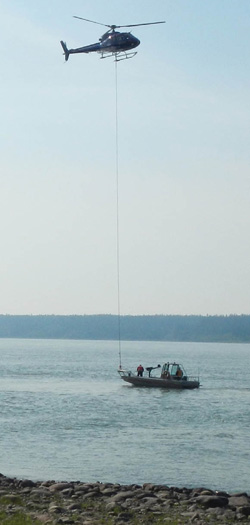 Business and Services Restructuring Proposal and 2012 and 2013
Business and Services Restructuring Proposal and 2012 and 2013
Mainline Final Tolls
On 27 March 2013, the NEB announced its decision to fix multi-year tolls on the TransCanada Mainline. In its application, TransCanada PipeLines Limited (TransCanada) asked the Board to consider restructured pipeline services and tolling across its pipeline network, which includes the Mainline, the Alberta System and the Foothills System. The Board approved multi-year fixed tolls that are competitive and provide TransCanada with a reasonable opportunity to recover its Mainline costs, given the increase in Mainline throughput that is forecast. Please see the NEB’s website to read the complete decision.
Transportation Service and Toll Methodology for the Expanded Trans Mountain Pipeline System
On 16 May 2013, the NEB approved the application by Trans Mountain Pipeline ULC (Trans Mountain) under Part IV of the NEB Act for the toll methodology that would be implemented on the proposed Trans Mountain expanded system, if the system is eventually expanded. The Board found, on balance, that the toll methodology as proposed by Trans Mountain will produce tolls that will be just, reasonable and not unjustly discriminatory. Please see the NEB’s website to read the complete decision.
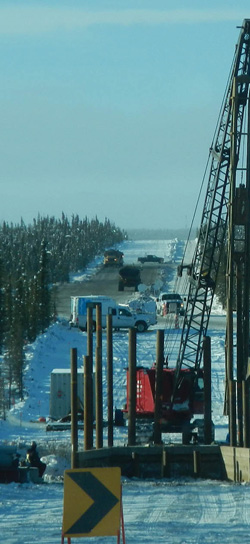 Chevron Priority Destination Designation for Burnaby Refinery
Chevron Priority Destination Designation for Burnaby Refinery
On 11 July 2013, the NEB denied the application by Chevron Canada Limited (Chevron) to designate its Burnaby Refinery a priority destination pursuant to section 1.58 of the Tariff of Trans Mountain Pipeline ULC (the Tariff). Under section 1.58 of the Tariff, "priority destination" means a refinery, marketing terminal or other facility connected to and capable of receiving petroleum from the Trans Mountain Pipeline system (the Pipeline), and so designated by the Board by reason that it is not capable of being supplied economically from alternative sources. This is the first time the NEB has considered an application for Priority Destination Designation (PDD). Please see the NEB’s website to read the complete decision.
TransCanada Tariff Amendments
On 10 October 2013, the NEB approved the application by TransCanada to amend its Canadian Mainline Gas Transportation Tariff. The Board denied some elements of the application and amended others. Please see the NEB’s website to read the complete decision.
Part VI - Imports and Exports
LNG Canada Development Inc.
On 4 February 2013, the Board approved an application by LNG Canada Development Inc. (LNG Canada) for a licence to export liquefied natural gas (LNG) from a proposed terminal near Kitimat, British Columbia. The export licence authorizes LNG Canada to export 670 million tonnes of LNG (approximately equivalent to 32.95 trillion cubic feet of natural gas) over a 25-year period. Please see the NEB’s website to read the complete decision.
Prince Rupert LNG Exports Ltd.
On 16 December 2013, the Board approved an application by Prince Rupert LNG Exports Ltd. (Prince Rupert LNG) for a licence to export LNG from a proposed terminal located on Ridley Island, British Columbia. The export licence authorizes Prince Rupert LNG to export 824.58 109m³ over a 25-year period. Please see the NEB website to read the complete decision.
Pacific Northwest LNG Ltd.
On 16 December 2013, the Board approved an application by Pacific Northwest LNG Ltd. (Pacific Northwest LNG) for a licence to export LNG from a proposed terminal located on Lelu Island within the District of Port Edward, British Columbia. The export licence authorizes Pacific NorthWest LNG to export 798.96 109m³ over a 25-year period. Please see the NEB website to read the complete decision.
WCC LNG Ltd.
On 16 December 2013, the Board approved an application by WCC LNG Ltd. (WCC LNG) for a licence to export LNG from a proposed terminal located in the vicinity of either Kitimat or Prince Rupert, British Columbia. The export licence authorizes WCC LNG to export 1,102.97 109m³ over a 25-year period. Please see the NEB website to read the complete decision.
Woodfibre LNG Export Pte. Ltd.
On 16 December 2013, the Board approved an application by Woodfibre LNG Export Pte. Ltd. (Woodfibre LNG) for a licence to export LNG from a proposed terminal located near Squamish, British Columbia. The export licence authorizes Woodfibre LNG to export 85.52 109m³ over a 25-year period. Please see the NEB website to read the complete decision.
Legislated Time Limits and NEB Service Standards and Results in 2013
Legislated Time Limits
As a result of the Jobs, Growth and Long-term Prosperity Act, the NEB has fixed beginning-to-end time limits of 18 months for most applications - 15 months for the NEB to complete its assessment and three months for the GiC to make a decision. In 2013, the NEB did not miss a time limit for any of its hearings. Going forward, the Board does not anticipate any issue with meeting time limits with respect to applications that are subject to time limits. All hearings over the last eight years, with the exception of two joint review panel hearings, have been completed within 15 months of the time from when a hearing order was issued to the release of a decision or recommendation.
NEB Service Standards and Results in 2013
Service standards are an essential tool in today’s results-based management environment. The NEB has its own internal service standards for many regulatory functions and services. The Board communicates to the public and stakeholders the expected timeline in which an application or request will be processed, having due regard to the assessment it must carry out to fulfill the NEB’s mandate as stipulated in the legislation.

The following Tables 10, 11 and 12 list the overall NEB service standards and results, as well as the standards and results for electricity export applications and section 58 applications in 2013.
| Task | Service Standard | No. of Applications or Requests |
Results |
|---|---|---|---|
| Release of Hearing Decisions and Recommendations | 80% of Hearing Decisions and Recommendations completed within 12 weeks following a public hearing | 12 | 92% |
| COGO Act Applications to drill a well | Decision rendered within 21 calendar days of the receipt of a complete application | 6 | 100% |
| COGO Act Applications to alter the condition of a well | Decision rendered within 21 calendar days of the receipt of a complete application | 6 | 100% |
| COGO Act Geological and Geophysical Applications | Decision rendered within 30 calendar days of the receipt of a complete application | 1 | 100% |
| Authorization for export of crude oil and/or petroleum products | Two working days (short-term orders only) | 24 | 100% |
| Authorization for export and import of natural gas | Two working days (short-term orders only) | 169 | 98% |
| Authorization for export of NGLs | Two working days (short-term orders only) | 6 | 100% |
| CPR Act Applications | 80% of decisions rendered within 90 calendar days from the receipt of a complete application | 1 | 0%[19] |
| Landowner Complaint Process | 100% of requests responded to within 10 calendar days | 11 | 100% |
| Financial Audits | 80% of draft audit reports will be sent to the company within eight weeks of field work completion | 1 | 100% |
| Category | Category Description | Service Standard | No. of Applications | Results |
|---|---|---|---|---|
| A | Minor complexity of issues | 80% of decisions released within 40 calendar days following the completion of the Notice of Application period | 4 | 100% |
| B | Moderate complexity of issues | 80% of decisions released within 90 calendar days following the completion of the Notice of Application period | 0 | N/A |
| C | Major complexity of issues | No service standard | N/A | N/A |
| Category | Category Description | Service Standard | No. of Applications | Results |
|---|---|---|---|---|
| A | Minor complexity of issues with no third party interest | 80% completed within 40 calendar days of the receipt of a complete application | 0 | N/A |
| B | Moderate complexity of issues with possible third party interest | 80% completed within 90 calendar days of the receipt of a complete application | 26 | 96% |
| C | Major complexity of issues with likely third party interest | 80% completed within 120 calendar days of the receipt of a complete application | 14 | 100% |
In the Public Interest
The purpose of the NEB is to regulate pipelines, energy development and trade in the Canadian public interest. The NEB listens to what Canadians have to say about how energy infrastructure is developed and regulated, engaging them in meaningful dialogue about issues and solutions, and publically sharing information about regulatory initiatives.
The Board remains committed to listening to Canadians in support of realizing shared objectives for safety and environmental protection.
NEB Engagement
| Engagement Type | 2011 | 2012 | 2013 |
|---|---|---|---|
| Application-specific | 56 | 23 | 45 |
| Non-application specific | 22 | 13 | 9 |
Participation of Aboriginal Groups in the Regulatory Process
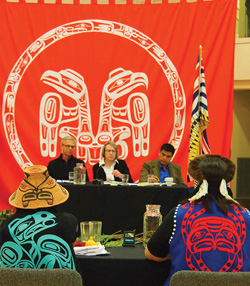 We are committed to ensuring that appropriate engagement is carried out for projects where there is a potential impact on the rights and interests of Aboriginal peoples. The Board’s Enhanced Aboriginal Engagement (EAE) initiative aims to provide proactive contact with Aboriginal groups that may be affected by a proposed project, and to help Aboriginal groups understand the Board’s regulatory process as well as how to participate in that process. In 2013, under the EAE initiative, we contacted nearly 188 Aboriginal communities and organizations, and held 19 meetings with interested Aboriginal communities and organizations. These meetings provided an opportunity for Aboriginal representatives to ask questions and provide feedback about NEB processes directly to NEB staff.
We are committed to ensuring that appropriate engagement is carried out for projects where there is a potential impact on the rights and interests of Aboriginal peoples. The Board’s Enhanced Aboriginal Engagement (EAE) initiative aims to provide proactive contact with Aboriginal groups that may be affected by a proposed project, and to help Aboriginal groups understand the Board’s regulatory process as well as how to participate in that process. In 2013, under the EAE initiative, we contacted nearly 188 Aboriginal communities and organizations, and held 19 meetings with interested Aboriginal communities and organizations. These meetings provided an opportunity for Aboriginal representatives to ask questions and provide feedback about NEB processes directly to NEB staff.
In an effort to make public hearings more accessible to Aboriginal people, the NEB adapts its processes to assist interested Aboriginal groups so they may effectively participate. The Board continues to integrate Aboriginal ceremonies and traditional practices into a hearing process at the request of Aboriginal participants. Suggestions made by both Aboriginal and non-Aboriginal hearing participants are considered in choosing hearing location and timing in order to make the hearing as accessible as possible. For example, during the Joint Review Panel’s Northern Gateway Project hearing, remote participation during the oral hearings was made available through the use of telephone and video links. Often, hearings were held in Aboriginal communities. The Panel sought, in particular, to hear from Aboriginal groups in a manner that was responsive to, and respectful of, Aboriginal traditions.
Participant Funding
Public participation is an important element of an open and effective regulatory process.
The NEB administers a Participant Funding Program which provides financial assistance to support timely and meaningful engagement of individuals, Aboriginal groups, landowners, incorporated non-industry not-for-profit organizations, or other interest groups who seek to intervene in the NEB’s oral hearing process for facilities applications.
Since the program began in 2010, the NEB has made available more than $2,500,000 to support public participation in 10 hearings.
The Process Advisor Role
The formation of the role of Process Advisor is a part of the public commitment the Board made in 2009, under the Land Matters Consultation Initiative[20], to provide additional process support to non-industry intervenors as well as increase the capacity of non-industry intervenors to participate in NEB hearing processes. Since March 2010, the NEB has been using the role of Process Advisors to help the public and Aboriginal groups participate in public hearings by providing the following support:
- answer questions about the Board’s hearing process;
- explain the different ways to participate (intervenor, letter of comment, oral statement) and what participants can and cannot do in these various roles;
- organize and run public information sessions;
- answer questions about the Participant Funding Program (PFP) and forms;
- discuss how one can participate in the PFP process;
- provide samples and templates of various documents which may be generated during the public proceeding and answer questions; and,
- answer process questions in person during the oral hearing.
In 2013, Process Advisors offered the following services in order to assist the public and Aboriginal groups understand the hearing process and educate them about available tools including:
- 9 WebEx presentations;
- 27 public information sessions; and
- communicating via phone calls and e-mails.
The NEB makes decisions/recommendations in the public interest, which is why the participation process is so essential.
Participation in a Facilities Hearing (General Information on Directly Affected/Standing)
The NEB makes decisions/recommendations in the public interest, which is why the participation process is so essential. We recognize the importance of hearing from the people who have a stake in a proposed facility project. More specifically, the Board will hear from people who stand to be directly affected by a proposed project, and may hear from those who have information and expertise that could help the hearing panel gain a greater understanding of a given matter under consideration.
Section 55.2 of the NEB Act sets out when the Board will allow a person to participate in a hearing to consider an application to construct and operate a pipeline or power line. A "person" may be defined as an individual, company, organization, or group.
If a person wishes to participate, they must demonstrate to the Board’s satisfaction that they are: a) directly affected by the proposed project; b) have relevant expertise or relevant information about the project for the Board to consider, or c) both.
Safety During the Public Hearing Process
One of the goals of our public hearing process is to hear from those directly affected by a proposed project. We work tirelessly to provide a safe and respectful environment to ensure a broad range of perspectives are incorporated into our decisions. Safety is always our first priority - safety of hearing participants and the general public who attend our hearings. As part of this commitment, we conduct a security assessment on a hearing location prior to any hearing, and would look at things such as publicly available information to assess any prior planned events that may have an impact on a venue. We work with local officials and federal colleagues such as the RCMP to conduct the assessment. We also look to the Canada Labour Code to ensure we are meeting all requirements for a safe public hearing. We use this information to ensure that plans are in place to protect everyone participating, for example the placement of security officers, emergency evacuation plans or online participation, etc. Part of regulating in the public interest is to hear from the public, and providing a safe environment is crucial in following through on that purpose.
NEB Land Matters Group
The Land Matters Group (LMG) was established by the Board to increase the dialogue amongst members of the public, Aboriginal groups and industry who have an interest in land matters and are impacted by the activities of NEB-regulated companies. The list of members include: The Alberta Energy Regulator, Farmers Advocacy Office (British Columbia), Canadian Association of Petroleum Producers, Union des producteurs agricoles du Québec, Union of Ontario Indians, Canadian Federation of Agriculture, The Canadian Energy Pipeline Association, West Coast Environmental Law, Synergy Alberta, The Canadian Energy Pipeline Association, Metis National Council and the NEB. Members participate in a variety of ways including a Steering Committee and sub-committees that are supported by NEB staff and resources.
The LMG Steering Committee met twice in 2013 - once in September and again in December. These meetings included updates and discussions on emerging issues of the various organizations represented, as well as presentations on various Board initiatives including:
- Proposed changes to Damage Prevention Regulations;
- Safety Culture Framework;
- NEB’s online Application to Participate form;
- Land Agent code of conduct and training;
- Physical Pipeline Abandonment; and
- Administrative Monetary Penalties.
The LMG continues to be a key resource for the Board in providing expert advice for emerging initiatives on content, consultation processes and effective rollout.
NEB in the North
Northern Engagement 2013
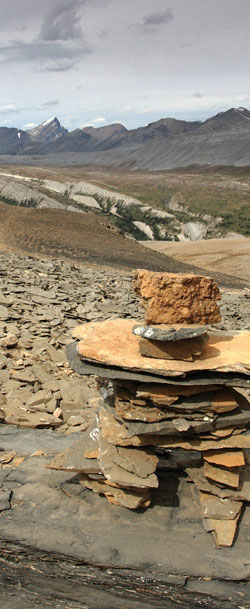 In the past year, the Board has continued to expand northern engagement activities through meetings with northern communities, youth, governments, environmental non-government organizations, regulatory agencies, and land claim institutions. Through these meetings, and through cultural awareness tours, the Board remains committed to listening to those who would be most affected by oil and gas activities in Canada’s North[21]in support of realizing shared objectives for safety and environmental protection.
In the past year, the Board has continued to expand northern engagement activities through meetings with northern communities, youth, governments, environmental non-government organizations, regulatory agencies, and land claim institutions. Through these meetings, and through cultural awareness tours, the Board remains committed to listening to those who would be most affected by oil and gas activities in Canada’s North[21]in support of realizing shared objectives for safety and environmental protection.
Over the past year, the Chair and CEO, Board Members, and NEB staff held over 50 meetings across the North. These meetings have involved, among other things, discussing key concerns around oil and gas exploration and development, explaining the Board’s role, and getting feedback during the development of guidelines to clarify the Board’s expectations of regulated companies.
- In May 2013, the Board released Draft Financial Viability and Financial Responsibility Guidelines which describe what applicants must do in order to demonstrate that they have the financial resources to conduct their proposed activities safely. The comment period for the draft guidelines closed 31 October 2013. All comments are currently being reviewed and will be carefully considered in developing the guidelines.
- In September 2013, the Board released Filing Requirements for Onshore Drilling Operations Involving Hydraulic Fracturing, which includes provisions addressing hydraulic fracturing related to onshore drilling and production in the North.
- The Board is currently developing Filing Requirements for Geoscience Programs which will specify the information needed to support an application for geophysical, geological or geotechnical operations and seabed surveys.
In February 2013, the NEB signed a MOU with the Mackenzie Valley Land and Water Board. This will further supplement existing MOUs that the NEB has across the North with other co-management boards that share responsibilities for environmental screening and assessment. These MOUs provide for technical training, information exchange, and regulatory coordination between the National Energy Board and the Northern Boards.
The NEB reaches out in the North through on-going engagement opportunities in many forms, including over 50 meetings in 2013.
These northern engagement initiatives, together with the Board’s continuing participation in a number of working groups including, for example, the NWT Board Forum, the Arctic Council, the Beaufort Regional Environmental Assessment, emergency preparedness exercises (such as the CANUSNORTH exercise being planned for 2014 - see next section), and the Arctic Security Working Group, collectively demonstrate the Board’s commitment to working collaboratively with others responsible for the management of resources in the North.
Devolution
On 25 June 2013, a Devolution Agreement was signed between the Government of Canada, the Government of the Northwest Territories (GNWT), the Inuvialuit Regional Corporation, the Northwest Territories Métis Nation, the Sahtu Secretariat Incorporated, the Gwich’in Tribal Council, and the Tlicho Government. This agreement, targeted to take effect in April 2014, will transfer administrative control over public lands and inland waters, as well as law making powers from the Government of Canada to the GNWT. The NEB and GNWT are currently discussing how the oil and gas industry will be regulated post devolution.
The NEB will provide support to the GNWT to support a seamless transition to the new regulatory regime, and is working closely with GNWT and AANDC officials as they work to prepare an implementation plan to do so.
CANUSNORTH Exercise 2014
Under the Canada-United States Joint Marine Pollution Contingency Plan (JCP), the Canadian and United States Coast Guards are required to exercise each geographic annex to the plan every two years. The geographic annex that covers the transboundary waters of the Beaufort Sea is commonly referred to as "CANUSNORTH".
The National Energy Board, together with the Canadian and United States Coast Guards, are currently planning the CANUSNORTH 2014 exercise, to be held in Alaska in the summer of 2014. The exercise will be based on a hypothetical well control incident in the Beaufort Sea, and is intended to support preparedness requirements for a coordinated marine environmental response.
The Board believes in working collaboratively with our international federal partners. The NEB is committed to enhancing and developing cooperative agreements with other regulators.
Energy Markets 2013
 As part of its regulatory mandate, the Board monitors the integrated North American energy markets. The goal is to understand ongoing changes in the relationships between supply, infrastructure, demand and prices, as well as staying current on conditions in a fast evolving energy market. The Board encounters these market relationships as key features of applications to construct and modify facilities, establish tolls and tariffs, and provide export or import authorizations.
As part of its regulatory mandate, the Board monitors the integrated North American energy markets. The goal is to understand ongoing changes in the relationships between supply, infrastructure, demand and prices, as well as staying current on conditions in a fast evolving energy market. The Board encounters these market relationships as key features of applications to construct and modify facilities, establish tolls and tariffs, and provide export or import authorizations.
One of the outputs with respect to market intelligence collected at the Board is energy data and studies on specific energy issues. These products offer neutral, independent, fact based energy information which provides context to supplement Canadians’ understanding of the Board’s regulatory decisions. These products support the Board’s status as an expert tribunal, increase the transparency of Canadian energy markets and support Canadian energy literacy.
Under the Energy Information Program, the NEB monitors and analyzes a variety of data (supply, demand, price, transportation) and information with the goal of providing Canadians with information on important energy matters.
Canadian Energy Import/Export Volumes and Values
Crude Oil
Canada is a net crude oil exporter and the number one supplier of crude oil to the U.S. In 2013, total Canadian crude oil exports averaged approximately 2.59 million barrels per day (MMb/d), which is a 10 per cent increase from 2012. In 2013, the total value of crude oil exports is estimated at approximately C$83.05 billion based on an average export price of C$87.90 per barrel.
Figure 13 - Total Crude Exports 2003-2013
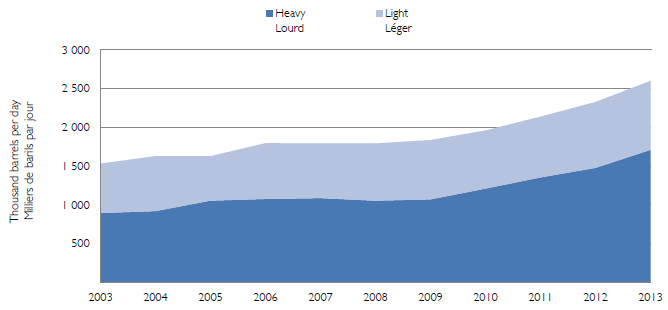
Did You Know?
Oil Exports in Context
Canada has approximately 172 billion barrels of established reserves of crude oil. In 2013 Canada produced 1.3 billion barrels of oil, or 3.2 million barrels each day. Around 2.5 million barrels per day were exported. At this rate, Canada could produce the same amount of oil every year for 134 years without any increase in established reserves.
What is a barrel of oil?
One barrel of oil equals approximately 158 litres. It can be used to produce 72 litres of gasoline and a host of other refined petroleum products such as jet fuel, distillates, and residual fuel oils.[22]
Natural Gas
In 2013, total Canadian natural gas exports averaged 228 million cubic metres per day (³/day). Total natural gas imports averaged 73 million m³/day, including average LNG imports of 3 million m³/day. Therefore, net exports averaged approximately 155 million m³/day, which is similar to 2012. In 2013, the value of natural gas exports is estimated at C$11.1 billion. The value of natural gas imports is estimated at C$3.9 billion.
As described in the "Applications and Hearings in 2013" section, the Board approved five LNG export licences this year. This is in addition to two previously approved LNG export licences from 2012. Canadian LNG facilities to liquefy and export these volumes have yet to be constructed.
Figure 14 - Natural Gas Net Exports 2003-2013 (Exports less Imports)
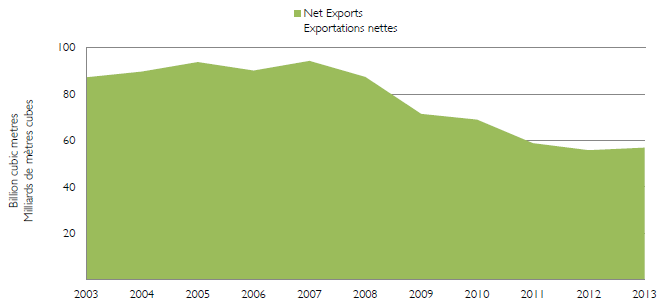
Did You Know?
Natural Gas Exports in Context
In 2013, Canada produced 4.6 trillion cubic feet (Tcf) of natural gas, with about 2.9 Tcf used in Canada and about 1.7 Tcf exported to the U.S. Canada has an estimated 1,093 Tcf of remaining marketable gas resources, which is equivalent to 238 years of production at current rates.
What is a million cubic metres of natural gas?
1 million m³ of natural gas equals 1 billion litres. This is enough natural gas to supply 700 average Canadian homes for one year.
Electricity
In 2013, Canadian electricity exports averaged 63 terawatt hours (TWh). Total electricity imports reached 11 TWh. Net exports rose to a record 52 TWh, up 11 per cent from 2012. The total value of electricity trade in 2013 was approximately C$2.7 billion.
What is a TW of electricity?
1 TW of electricity = 1,000,000,000 kilowatt hours (kWh). Based on average consumption of 925 kWh per month, can power approximately 90,000 Canadian homes for one year.
Figure 15 - Electricity Net Exports 2003-2013
(Exports less Imports)
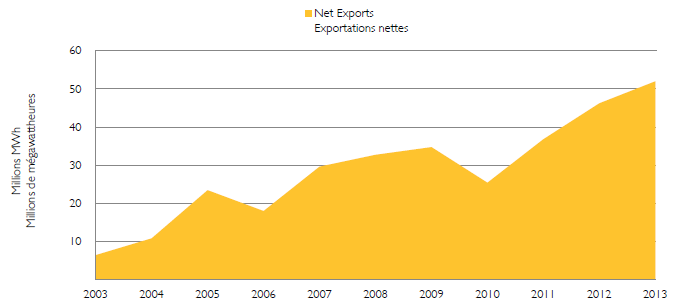
Did You Know?
Electricity Exports in Context
Several Canadian provinces rely on hydro-electricity for power. The amount of electricity produced is determined by precipitation and water level, which can vary dramatically by season. Since electricity storage options are limited, any surplus electricity generated is exported. Run-of-river hydro is used or exported immediately. On the other hand, provinces with the ability to store water behind dams are able to adjust the rate of production and optimize value by producing electricity or waiting without any increase in marketable electricity resources.
NEB Energy Reports Released in 2013
Each year, the Board releases several publications on Canadian energy supply and demand and short-term energy outlooks. An annual Canadian Energy Overview (CEO) is also published which provides an analysis of energy markets and trends from the previous year. The 2012 CEO noted that domestic energy production increased by about two per cent, with growth in petroleum partially offset by a decline in natural gas production. At the same time, domestic energy consumption grew slightly in all categories, and overall by 1.1 per cent in 2012.
In November, the Board published its flagship energy report, Canada’s Energy Future 2013: Energy Supply and Demand Projections to 2035 (EF 2013). The results indicated that there will be adequate supply to meet Canada’s growing energy needs over the forecast period. In 2013, energy production levels were projected to exceed domestic requirements, resulting in growing amounts of energy available for export.
Canadian energy needs will increase as well, but at a slower rate than the historical trend. Growth in Canadian natural gas production is supported by the first study ever to estimate the marketable unconventional petroleum resources in the Montney Formation (Figure 16). The Ultimate Potential for Unconventional Petroleum from the Montney Formation of British Columbia and Alberta - Energy Briefing Note, released in November, was conducted by the Board together with the British Columbia Oil and Gas Commission, the British Columbia Ministry of Natural Gas Development and the Alberta Energy Regulator.
Figure 16 - The Montney Formation (Modified from the Geological Atlas of the Western Canada Sedimentary Basin)
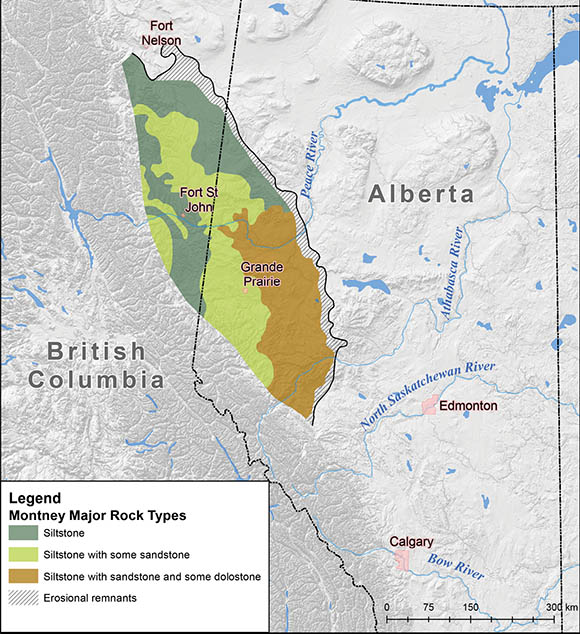
As stated in the report, the Montney Formation is one of the largest natural gas resources in the world. Recent advances in technology have made it possible to economically develop unconventional gas and oil in the Montney Formation over the past several years, but little had been known about its total potential. When combined with what is known about the marketable gas potential from conventional resources and other unconventional resources, it is expected that Canadian gas markets will remain well supplied into the future.
Drilling undertaken in the Montney Formation in 2013 and in the short-term will be focused on marketable natural gas liquids and oil as described in the Board’s Short-Term Natural Gas Deliverability 2013-2015 report, released in May. The report discusses key supply and demand drivers influencing future Canadian natural gas deliverability.
Energy production levels were projected to exceed domestic requirements, resulting in growing amounts of energy available for export.
Part VI - Export & Import of Natural Gas, Crude Oil and Electricity
Part VI of the NEB Act authorizes the Board to issue orders, licences and permits for imports of natural gas (including liquefied natural gas) and exports of: oil (including refined petroleum products), natural gas (including liquefied natural gas), natural gas liquids and electricity. Table 17 provides an overview of all orders, licences and permits issued by the Board in 2013.
| Totals in 2013 | New | Amendments | Renewals | Revocations | Total |
|---|---|---|---|---|---|
| Propane short-term export orders | 3 | 1 | 64 | - | 68 |
| Butane short-term export orders | 3 | 1 | 51 | - | 55 |
| Oil short-term export orders | 26 | 3 | 152 | 2 | 183 |
| Natural gas short-term export and import orders | 158 | 5 | n/a | 6 | 169 |
| Natural gas long-term licences | 5 | - | - | - | 5 |
| Natural gas long-term orders | 1 | - | - | - | 1 |
| Electricity export permits issued | 4 | 22 | n/a | 15 | 41 |
| Total | 199 | 32 | 267 | 23 | 522 |
NEB People and Culture
A Flexible and Efficient Workspace - the NEB is Moving!
The Board will be relocating to the Centre 10 building, 517 - 10th Avenue SW in Calgary, in 2014. Our e-mail addresses, toll free number 1-800-899-1265 and fax number 1-877-288-8803 will not change. We look forward to continuing to serve the public from our new location.
The NEB People Strategy
The Board takes pride in its technical and professional excellence as a regulator, and strives to attract, retain and develop highly qualified staff to work in a dynamic, results-based culture of excellence. Employees are our most valued resource and we depend on them to make our goals a reality. In our People Strategy, we commit to providing the following value proposition to staff:
- interesting and challenging work in the national public interest;
- a workplace that supports learning and professional development;
- a supportive and inclusive workplace, underpinned by a strong culture of values;
- a work/life balance that works for each person;
- a competitive compensation package; and
- effective leadership.

Employment Equity and Diversity
The National Energy Board is committed to employment equity and welcomes diversity in the workplace. A diverse workforce that mirrors the community strengthens the NEB and plays an important role in attracting and retaining talented employees.
We will continue to promote diversity within the workforce and continue to improve our representation in the various employment equity groups.
NEB is a Top 100 Employer in Canada!
In October of 2013, the NEB was again named as one of Canada’s Top 100 Employers for 2014 for the fourth year in a row (the NEB is a five-time winner as we were also named in 2009). In addition to that honour, we were also named as one of Canada’s Top 100 Family Friendly Employers for 2014, a designation that recognizes employers offering progressive and forward-thinking programs for employees with young children, other dependents, and/or family responsibilities.
The Board is pleased to receive these honours as they showcase not only the types of programs offered to employees; they also focus on the employees themselves. The NEB is not just a Top 100 Employer and Family Friendly Employer; it is a "Top 100 Team" that strives for excellence in all that it does.
A Wealth of Experience
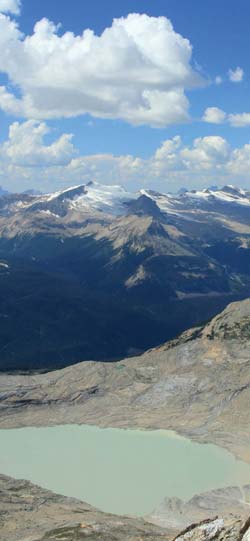 Complete biographies for current Members can be found on our website under Who we are & our Governance > Organization and Structure.
Complete biographies for current Members can be found on our website under Who we are & our Governance > Organization and Structure.
Chair and CEO - Gaétan Caron
Vice-Chair - Sheila Leggett
(end of term December 2013)
Permanent Members
Roland George
Kenneth Bateman
Lyne Mercier
Philip Davies
Shane Parrish
Don Young
Ron Wallace
Georgette Habib (end of term October 2013)
Temporary Members
David Hamilton
Bob Vergette
Hans Matthews (end of term December 2013)
Alison Scott
James Ballem
Mike Richmond
Jacques Gauthier
Appendix A:
| Name | File Number | Company | Length | Commodity | Application Received | Hearing Days | Recommen-dation / Decision Released |
|---|---|---|---|---|---|---|---|
| Northwest Mainline Komie North Extension Project | GH-001-2012 [Filing A50255] | NOVA Gas Transmission Ltd. | 33 km | Gas | 14 October 2011 | 10 | 30 January 2013 |
| LNG Canada Export Licence | N/A [Filing A50334] | LNG Canada Development Inc. | N/A | Liquefied natural gas | 27 July 2012 | Written | 4 February 2013 |
| Preliminary Cost Estimates | MH-001-2012 [Filing A56300] | Group 1 Companies | N/A | N/A | 29-30 November 2011 | 7 | 14 February 2013 |
| Business and Services Restructuring Proposal and 2012 and 2013 Mainline Final Tolls | RH-003-2011 [Filing A51040] | TransCanada Pipelines Limited, NOVA Gas Transmission Ltd., and Foothills Pipe Lines Ltd. | N/A | Gas | 1 September 2011 | 72 | 27 March 2013 |
| Transportation Service and Tolls Methodology for Expanded Trans Mountain Pipeline System | RH-001-2012 [Filing A51913] | Trans Mountain Pipeline ULC | N/A | Oil | 29 June 2012 | 7 | 16 May 2013 |
| Application for Tariff effective 1 November 2011 and Tolls effective 1 January 2012 | RHW-001-2012 [Filing A51977] | Centra Transmission Holdings Inc. | N/A | Gas | 19 September 2011 | Written | 22 May 2013 |
| Chevron Priority Destination | MH-002-2012 [Filing A52851] | Chevron Canada Limited | N/A | Oil | 19 June 2012 | 6 | 11 July 2013 |
| Amendments to Transportation Access Procedure | RH-002-2013 [Filing A54319] | TransCanada Pipelines Limited | N/A | Gas | 9 September 2013 | 1 | 25 September 2013 |
| TransCanada Tariff Amendments | RH-001-2013 [Filing A55497] | TransCanada Pipelines Limited | N/A | Gas | 17 June 2013 | 9 | 10 October 2013 (Reasons for Decision released 25 November 2013) |
| Abandonment of Coutts Gas Export Pipeline | MHW-002-2013 [Filing A54982] | AltaGas Holdings Inc. | N/A | Gas | 7 May 2013 | Written | 29 October 2013 |
| Abandonment of Maple Creek Pipeline | MHW-004-2013 [Filing A55528] | Enerplus Corporation | N/A | Gas | 29 May 2013 | Written | 26 November 2013 |
| Dysert Farms Ltd. Section 83 NEB Act Application | MHW-001-2013 | N/A | N/A | N/A | 13 September 2012 | Written | 28 November 2013 |
| Abandonment of Pipelines at Wild Horse Border Crossing | MHW-003-2013 [Filing A55784] | Forty Mile Gas Co-op Ltd. | N/A | Gas | 20 March 2013 | Written | 6 December 2013 |
| Prince Rupert LNG Export Licence | N/A [Folder 977381 | Prince Rupert LNG Exports Limited | N/A | Liquefied natural gas | 17 June 2013 | Written | 16 December 2013 |
| Woodfibre LNG Export Licence | N/A [Folder 977584] | Woodfibre LNG Exports Pte. Ltd. | N/A | Liquefied natural gas | 23 July 2013 | Written | 16 December 2013 |
| Pacific NorthWest LNG Export Licence | N/A [Folder 971021] | Pacific NorthWest LNG Ltd. | N/A | Liquefied natural gas | 5 July 2013 | Written | 16 December 2013 |
| WCC LNG Export Licence | N/A [Folder 977286] | WCC LNG Ltd. | N/A | Liquefied natural gas | 19 June 2013 | Written | 16 December 2013 |
| Northern Gateway Project | OH-4-2011 [Filing A56136] | Northern Gateway Pipelines Inc. | Two pipelines of 1178 km each | Oil | 27 May 2010 | 64 days in 2013 | 19 December 2013 |
Appendix B:
| Name | File Number | Company | Length | Commodity | Application Received | Hearing Days |
|---|---|---|---|---|---|---|
| Edmonton to Hardisty Pipeline Project | OH-001-2013 [Filing A56736] | Enbridge Pipelines Inc. | 182 km | Oil | 14 December 2012 | 5 |
| Line 9B Reversal and Line 9 Capacity Expansion Project | OH-002-2013 [Filing A59170] | Enbridge Pipelines Inc. | N/A | Oil | 29 November 2012 | 7 |
| Set-Aside Mechanism and Collection Mechanism (SAM-COM) | MH-001-2013 [Folder 927998] | Group 1 and Group 2 Companies | N/A | N/A | Deadline for Group 1 Companies 28 February 2013 and Deadline for Group 2 Companies 31 May 2013 | Not yet started |
| Jordan Cove LNG L.P. Export Licence | N/A [Folder 1035410] | Jordan Cove LNG L.P. | N/A | Liquefied natural gas | 9 September 2013 | Written |
| Triton LNG Limited Partnership Export Licence | N/A [Folder 1057402] | Triton LNG Limited Partnership | N/A | Liquefied natural gas | 29 October 2013 | Written |
Appendix C - Court Challenges to Board or GiC Decisions in 2013
The following is a summary of challenges to Board decisions in 2013.
Geophysical Services Incorporated (Lynx Canada Information Systems Ltd.)
In June 2009, Geophysical Service Incorporated (GSI) took legal action against Lynx Canada Information Systems Ltd. (Lynx) in the Alberta Court of Queen’s Bench for copyright infringement relating to geophysical information and related relief. On 27 May 2011, Lynx brought a Third Party Claim against the National Energy Board. On 30 October 2012, GSI filed an Amended Statement of Claim naming the NEB directly as a defendant for the full amount of its claim. On 18 July 2013, the NEB filed a Statement of Defence. The file is presently ongoing.
NOVA Gas Transmission Ltd. - Final 2011 Tolls for the Alberta System and Implementation of Alberta System Integration
On 16 September 2011, Altagas Ltd. filed with the Federal Court of Appeal a Notice of Motion for Leave to Appeal of the NEB letter decision and Order TG-05-2011 dated 19 August 2011, approving Implementation of Alberta System Integration. On 19 September 2011, BP Canada Energy Company filed with the Federal Court of Appeal a Notice of Motion for Leave to Appeal the same NEB decision and Order. The Court granted both Motions on 10 November 2011. The appeals were discontinued by the appellants in January 2013.
Geophysical Services Incorporated (Olympic Seismic Ltd.)
On 19 December 2012, GSI filed with the Alberta Court of Queen’s Bench a Statement of Claim naming Olympic Seismic Ltd. and the NEB as defendants for copyright infringement relating to geophysical information and related relief. The NEB filed a Statement of Defence on 30 January 2013. The file is presently ongoing.
Fort Nelson First Nation
On 1 March 2013, Fort Nelson First Nation filed with the Federal Court of Appeal a Notice of Application for Judicial Review of the NEB report dated 30 January 2013 regarding the Northwest Mainline Komie North Extension. The Board had recommended that a certificate be issued for only a portion of the pipeline applied for by NOVA Gas Transmission Ltd. On 16 May 2013, the Court granted the Board’s motion for intervener status. The application for judicial review was discontinued by the Fort Nelson First Nation on 3 June 2013.
Geophysical Services Incorporated (Arcis Seismic Solutions Corp.)
On 6 March 2013, GSI filed with the Alberta Court of Queens’ Bench a Statement of Claim naming Arcis Seismic Solutions Corp., the NEB and others as defendants for copyright infringement relating to geophysical information and related relief. The NEB filed its Statement of Defence on 3 April 2013. The file is presently ongoing.
Geophysical Services Incorporated (West Canadian Digital Imaging Inc.)
In March 2013, GSI took legal action against West Canadian Digital Imaging Inc. (West Canadian) in the Alberta Court of Queen’s Bench for copyright infringement relating to geophysical information and related relief. On 13 March 2013, West Canadian brought a Third Party Claim against the National Energy Board. The NEB was subsequently added as a defendant on 22 July 2013. A Statement of Defence was filed with the Court on 13 September 2013. The file is presently ongoing.
Gitxaala Nation
On 6 March 2013, Gitxaala Nation filed with the Federal Court of Appeal a Notice of Motion for Leave to Appeal the Board’s decision of 4 February 2013, to grant LNG Canada Development Inc. a 25-year natural gas (LNG) export licence. The Court dismissed the Application for Leave to Appeal on 16 April 2013. A related Notice of Application for Judicial Review of the Board’s decision was filed on 26 March 2013, although the NEB was not named as a Respondent. The Application for Judicial Review was discontinued on 10 June 2013.
Alliance Pipeline Ltd. (MH-001-2012)
On 18 March 2013, Alliance Pipeline Ltd. filed with the Federal Court of Appeal a Notice of Motion for Leave to Appeal regarding the Board’s MH-001-2012 Reasons for Decision, dated 14 February 2013, about the Abandonment Cost Estimates of Group 1 companies. The Court dismissed the Motion on 16 July 2013.
ForestEthics Advocacy Association and Donna Sinclair (x2)
On 12 August 2013, ForestEthics and Donna Sinclair (Applicants) filed a Notice of Application for Judicial Review with the Federal Court of Appeal regarding Enbridge Pipelines Inc.’s (Enbridge) application for the Line 9B Reversal and Line 9 Capacity Expansion Project for the following relief. A declaration that s.55.2 of the NEB Act is unconstitutional under s.2(b) of the Charter; an order quashing the NEB’s decisions regarding standing; injunctions until this application is disposed of; and an order that the NEB accept all letters of comment from groups and individuals who seek to participate. The file is presently ongoing.
Appendix D - Certificates and Orders Oil
| Applicant | Order Number | Date Issued | Description |
|---|---|---|---|
| Enbridge Pipelines Inc. | XO-E101-001-2013 | 18 January 2013 | Application to install a new Drag Reducing Agent (DRA) skid at Enbridge’s Hardisty Terminal. |
| Enbridge Pipelines Inc. | XO-E101-002-2013 | 31 January 2013 | Application to vary a portion of Order X0-E101-001-2013 relating to the piping specifications for the Line 67 DRA Skid Installation Project. |
| Enbridge Pipelines Inc. | XO-E101-003-2013 | 15 February 2013 | Application to construct a connection at Kerrobert Station for the injection of heavy crude onto Line 67 as well as a new connection at Stony Beach Takeoff. |
| Enbridge Pipelines Inc. | XO-E101-004-2013 | 21 February 2013 | Application to modify the following stations and terminals:, Metiskow, Kerrobert, Milden, Craik, Rowatt , Glenavon, Cromer, Glenboro and Gretna to increase the annual capacity of the Alberta Clipper Pipeline (Line 67). |
| Enbridge Pipelines Inc. | XO-E101-005-2013 | 28 March 2013 | Application to approve the Eastern Access Edmonton project - Terminal Connectivity Phase 1 which includes the installation of 20 new Triple Offset Valves in to the existing Manifold 201. |
| Enbridge Pipelines Inc. | XO-E101-007-2013 | 9 April 2013 | Application to decommission the Sarnia Terminal. |
| Enbridge Pipelines Inc. | XO-E101-008-2013 | 12 April 2013 | Application to modify the lateral Line 2 to accommodate required increased flow rates. |
| Enbridge Pipelines Inc. | XO-E101-010-2013 | 9 May 2013 | Application to install at the Hardisty Terminal a new NPS 42 tank line between Manifold 201 and Tank 47 as well as a modification of the existing shared line at Tanks 45 and 47. |
| Enbridge Pipelines Inc. | XO-E101-011-2013 | 13 May 2013 | Application to increase suction pressure at the Line 4 and the future Line 67 mainline pumps. |
| Enbridge Pipelines Inc. | XO-E101-012-2013 | 15 May 2013 | Application to disconnect the existing relief line from Tank 113 and re-route it to Tank 116 at Gretna Station. |
| Enbridge Pipelines Inc. | XO-E101-013-2013 | 17 May 2013 | Application to replace 33.6 km of our 609.44 mm (24-inch) Line 2 pipeline, proceeding south-east from the existing Edmonton Terminal to a valve located near Joseph Lake. |
| Enbridge Pipelines Inc. | XO-E101-014-2013 | 22 May 2013 | Application for the Eastern Access Edmonton Project, to construct and install new valves at six manifolds within Edmonton Terminal and transfer lines linking Manifolds 201 to 217, 206B to 210, and 210 to 221. |
| Enbridge Pipelines Inc. | XO-E101-016-2013 | 18 July 2013 | Application to construct and operate a new pipeline (the Line 3 Replacement) and approval to deactivate a segment of the existing Enbridge Line 3 pipeline. |
| Enbridge Pipelines Inc. | XO-E101-018-2013 | 25 July 2013 | Application for the Line 9 Replacement Project at Don River involving the re-route of a 770 m section of 762 mm outside diameter (OD) pipe. |
| Enbridge Pipelines Inc. | XO-E101-019-2013 | 30 July 2013 | Application for additional tank capacity expansion at the Cromer Terminal. |
| Enbridge Pipelines Inc. | XO-E101-017-2013 | 25 August 2013 | Application to construct additional tankage and associated infrastructure as an expansion of the Edmonton Terminal (South). |
| Enbridge Pipelines Inc. | XO-E101-021-2013 | 29 August 2013 | Application for a new 250,000 Bbl storage tank for Regina Terminal, to accept deliveries of Plains Wascana PSR crude as well as to accommodate existing tank. |
| Enbridge Pipelines Inc. | XO-E101-023-2013 | 24 October 2013 | Application to expand capacity of Line 7 to ensure that more domestic crude oil capacity is available to refineries. |
| Enbridge Pipelines (Westspur) Inc. | XO-E103-006-2013 | 8 April 2013 | Application to install a new metering facility at Steelman Terminal, as well as approximately 100 m of new piping to divert two existing incoming lines through the metering facility entering the Enbridge Westspur system. |
| Trans Mountain Pipeline ULC | XO-T260-009-2013 | 26 April 2013 | Application to: (1) construct approximately 200 m of 508 mm (20 inch) OD facility piping within the Edmonton Terminal; (2) sale of approximately 445 m of an existing and unutilized feeder pipeline from Trans Mountain to Pembina; and (3) construct approximately 450 m of 508 mm (20 inch) OD pipeline on Trans Mountain’s pipe racks within Pipeline Alley. |
| Trans Mountain Pipeline ULC | XO-T260-025-2013 | 18 November 2013 | Application for the Edmonton Terminal Tanks 29 & 30 for two new 250,000 barrel storage tanks at its Edmonton Terminal. |
Appendix E- Certificates and Orders Gas
| Order Number | Date Issued | Description | |
|---|---|---|---|
| Alliance Pipeline Ltd. | XG-A159-010-2013 | 3 July 2013 | Application to expand the Moose River Meter Station to accommodate increasing natural gas receipts on Alliance’s gathering network. |
| Burlington Resources Canada (Hunter) Ltd. | XG-B105-018-2013 | 26 September 2013 | Application to construct and tie-in a segment of pipe, and to decommission an existing segment of pipe located at the Beavertail Creek. |
| Canadian Natural Resources Limited | XG-C298-022-2013 | 10 December 2013 | Application to: (1) tie-in to the Ladyfern pipeline via a pipeline licenced under the jurisdiction of the AER; (2) reverse flow of the Ladyfern pipeline; and (3) remove a portion of the Ladyfern pipeline, from the jurisdiction of the NEB, to be licenced under the jurisdiction of the AER. |
| NOVA Gas Transmission Ltd. | XG-N081-006-2013 | 26 April 2013 | Application to construct and operate the Saddle Lake Lateral Loop. |
| NOVA Gas Transmission Ltd. | XG-N081-011-2013 | 9 July 2013 | Application to connect the NGTL System to ATCO Pipelines’ proposed Norma Transmission Pipeline. |
| NOVA Gas Transmission Ltd. | XG-N081-013-2013 | 13 August 2013 | Application for an order approving the construction and operation of the Sunday Creek South Lateral Loop No. 3. |
| NOVA Gas Transmission Ltd. | XG-N081-014-2013 | 15 August 2013 | Application for the Grey Owl Creek Receipt Meter Station to provide metering service for sweet natural gas to meet incremental receipt transportation service contract requirements to support the Peyto Exploration & Development Corp. (Peyto) Brazeau River gas plant. |
| NOVA Gas Transmission Ltd. | XG-N081-015-2013 | 13 September 2013 | Application for the Mitchell Creek Receipt Meter Station Project to provide metering service for sweet natural gas to meet incremental receipt transportation service contract requirements that will support the Tourmaline Oil Corporation Banshee plant production. |
| NOVA Gas Transmission Ltd. | XG-N081-016-2013 | 13 September 2013 | Application for Leming Lake Sales Lateral Loop to increase the gas delivery capability in this area, south to the Mahihkan Sales Meter Station and north to the Canoe Lake Sales No. 2 Meter Station. |
| NOVA Gas Transmission Ltd. | XG-N081-017-2013 | 25 September 2013 | Application to construct, own and operate the Denning Lake Compressor Station in the Municipal District of Bonnyville. |
| NOVA Gas Transmission Ltd. | XG-N081-019-2013 | 29 October 2013 | Application to provide additional capacity to meet incremental contracted demand throughout the Cold Lake and Kirby areas by creating an additional flow path for gas to reach the Leismer-Kettle River Crossover. |
| NOVA Gas Transmission Ltd. | XG-N081-021-2013 | 6 November 2013 | Application to provide metering service for sweet natural gas to meet incremental receipt transportation service contract requirements that will support the Musreau Deep Cut Plant. In addition, existing service at the NGTL Musreau Lake No. 2 meter station, will be relocated to the new Musreau Lake West meter station. |
| NOVA Gas Transmission Ltd. | XG-N081-023-2013 | 11 December 2013 | Application to provide metering service for sweet natural gas to meet incremental delivery transportation service contract requirements that will support the MacKay Operating Corp. (MOC) Steam Assisted Gravity Drainage (SAGD) operation. |
| Penn West Petroleum Ltd. | XG-P166-007-2013 | 30 April 2013 | Application to deactivate the Chinchaga Pipelines and pigging facilities. |
| TransCanada PipeLines Limited | XG-T211-001-2013 | 22 February 2013 | Application to replace the Westbrook Sales meter station to increase existing delivery capacity. |
| Talisman Energy Inc. | XG-T077-002-2013 | 25 February 2013 | Application for facilities to carry natural gas from the Talisman Narraway Well in west-central Alberta to the existing Talisman d-Ojay Well site facility in east-central British Columbia. |
| Westcoast Energy Inc., carrying on business as Spectra Energy Transmission (Westcoast) | XG-W102-003-2013 | 1 March 2013 | Application for leave to purchase from ConocoPhillips (BRC) Canada Partnership, Talisman Energy Canada, Penn West Petroleum and Penn West Petroleum Ltd. the Monkman Pipelines which consist of: 2 fuel gas and 2 sour gas pipelines in the Grizzly Valley area. Westcoast (Spectra) further applied to operate facilities that had previously been under BC Provincial jurisdiction. |
| Westcoast | XG-W102-005-2013 | 2 April 2013 | Application to increase compression capacity within the western portion of the Fort St. John Gathering System. |
| Westcoast | XG-W102-008-2013 | 2 May 2013 | Application for the North Montney Project to provide additional raw gas transmission and processing services in the Fort St. John area. The additional processing service will be provided at Aitken Creek Processing Plant and Westcoast’s McMahon Processing Plant. |
| Westcoast | XG-W102-020-2013 | 28 October 2013 | Application for the South Peace III Project to provide an additional 65 MMcf/d of raw gas gathering and processing services to McMahon Processing Plant. The additional transportation will be accomplished by constructing an approximately 4.6 kilometre loop of the Peace River Pipeline. |
| Westcoast | XG-W102-024-2013 | 17 December 2013 | Application to replace an approximately 750 m portion of the Yoyo Pipeline. |
| Applicant | Order Number | Date Issued | Description |
|---|---|---|---|
| NOVA Gas Transmission Ltd. | XG-N081-009-2013 | 17 January 2013 | Application for the extension and expansion of the Alberta System to receive and transport natural gas supply from the Horn River Basin and Cordova Embayment areas of NE BC. |
Appendix F - Financial Statements
The Board is funded by Parliament through the Appropriations Act, with approximately 90 per cent of its costs recovered by the Federal government from the companies whose energy facilities are regulated by the Board. Financial statements for cost recovery purposes are prepared annually and audited by the Office of the Auditor General. Table 18 provides an overview of NEB financial and human resources.
| Fiscal Year (1 April to 31 March) | Expenditures (Million $) | Staff (Full-Time Equivalents) |
|---|---|---|
| 2011-2012 | 64.4 | 393 |
| 2012-2013 | 69.6 | 398 |
| 2013-2014 | 84.2 | 427.6 |
Endnotes
[1] The public interest is inclusive of all Canadians and refers to a balance of economic, environmental and social considerations that changes as society’s values and preferences evolve over time.
[2] Total kms include pipelines that are approved, under construction, operational, deactivated, decommissioned, and pending abandonment.
[3] This value is derived from annual throughputs and the weighted average yearly commodity price.
[4] The Miscellaneous Program is an expedited process used to correct errors, omissions and inconsistencies in regulations.
[5] The IRF is a group of regulators of health and safety in the offshore upstream oil and gas industry. It exists to drive forward improvements in health and safety in the sector through collaboration in joint programs, and through sharing information.
[6] An inspection is an on-site, methodical examination and assessment of regulated activities or operations against requirements. Inspections may occur at any time during the life of a project.
[7] An audit is a systematic evaluation of management systems, including programs, practices, procedures, plans, processes, manuals, records, systems, and activities. The objective is to verify compliance with requirements. After being audited, a corrective action plan may be requested to resolve any findings of non-compliance within specific time limits.
[8] Previously referred to as NEB Assurance of Voluntary Compliance (AVC).
[9] A serious injury includes: the fracture of a major bone, the amputation of a body part, the loss of sight in one or both eyes, internal hemorrhage, third degree burns, unconsciousness or the loss of a body part or function of a body part.
[10] The definition of reportable incidents varies slightly under different legislation and regulations; however, the OPR covers the majority of NEB-regulated facilities.
[11] Data as of 31 December 2013: Please note that the incident data shown represents a single point in time. As new information becomes available, the incident record is updated. This information may change certain aspects of the incident record including whether the incident remains reportable under the applicable regulations. Accordingly, the incident data shown is subject to change.
[12] UAs as of 31 December 2013: UAs occurring in late 2013 may not be reported until early 2014. Therefore the information may be subject to change.
[13] Federal Lands include: internal waters of Canada and the territorial sea that are not within a province; National Parks; First Nation Reserves; 200 nautical miles offshore; and other federally-controlled lands.
[14] Group 1 Companies - companies that are regulated by the Board with more extensive pipeline systems.
[15] Group 2 Companies - companies that are regulated by the Board, and tend to have smaller pipeline systems with fewer shippers.
[16] Applications under section 52 of the NEB Act trigger a public hearing, either written or oral.
[17] Section 58 of the NEB Act permits the Board to make orders exempting certain facilities from any or all of the provisions of sections 29 to 33 and section 47 of the NEB Act. For more information, see Filing Manual Guide A.
[18] Under the NEB Act, the Board must hold a public hearing for pipeline projects that are more than 40 kilometres in length. The Board has discretion to hold a public hearing for pipeline projects that are less than 40 kilometres in length.
[19] Application was approved in 151 days. The service standard of 90 days was not met because it was the first application under the Canadian Petroleum Resources Act that was based upon unconventional resources and, therefore required a different approach in determining the extent of the discovery.
[20] The NEB’s Land Matters Consultation Initiative (LMCI) is a public forum for all interested parties and the Board to engage in dialogue and generate options to support the long-term responsible development of the energy sector.
[21] The NEB has regulatory responsibilities for oil and gas exploration and activities on frontier lands not otherwise regulated under joint federal/provincial accords. This currently includes the Northwest Territories, Nunavut, Arctic offshore, Hudson Bay, West Coast offshore, Gulf of St. Lawrence, a portion of the Bay of Fundy and onshore Sable Island.
[22] "What is a barrel of oil": U.S. refineries produce about 19 gallons of motor gasoline from one barrel (42 U.S. gallons) of crude oil. The remainder of the barrel yields distillate and residual fuel oils, jet fuel, and many other products. Taken from U.S. Energy Information Administration
[23] 2013-2014 are estimated amounts.

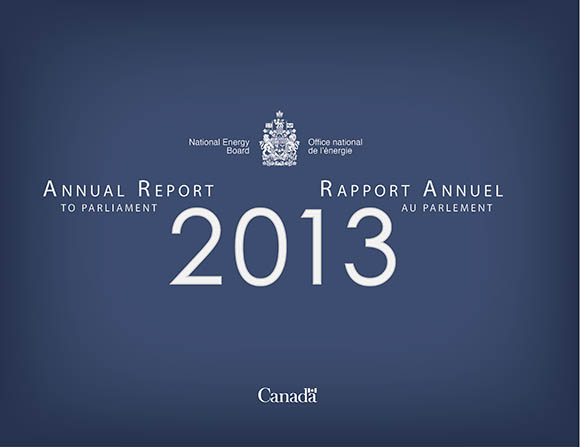
- Date modified:
